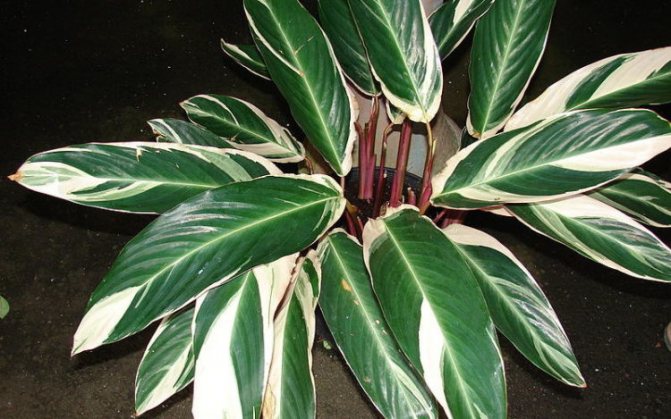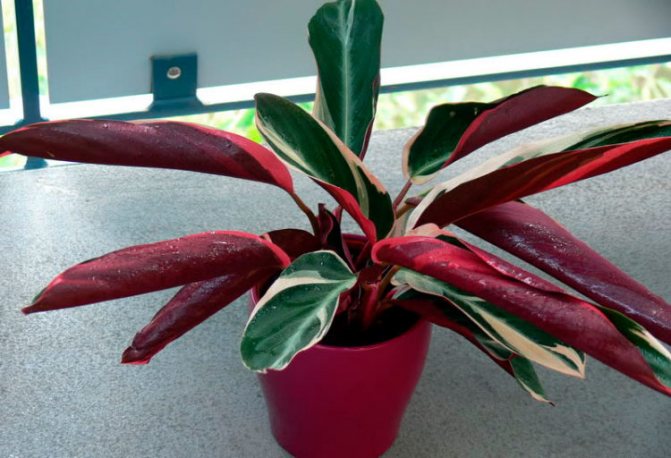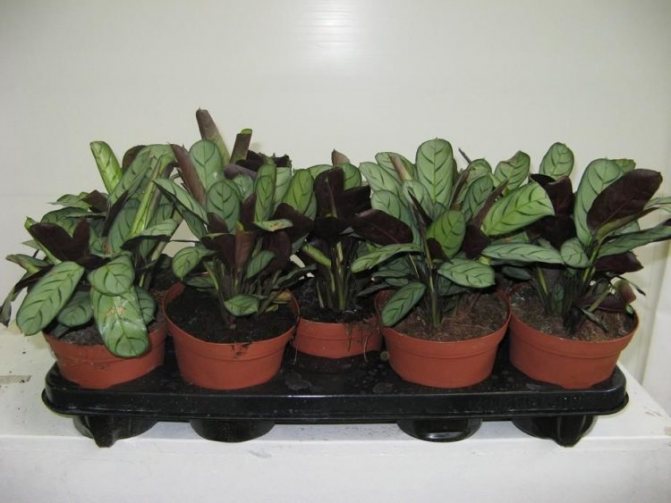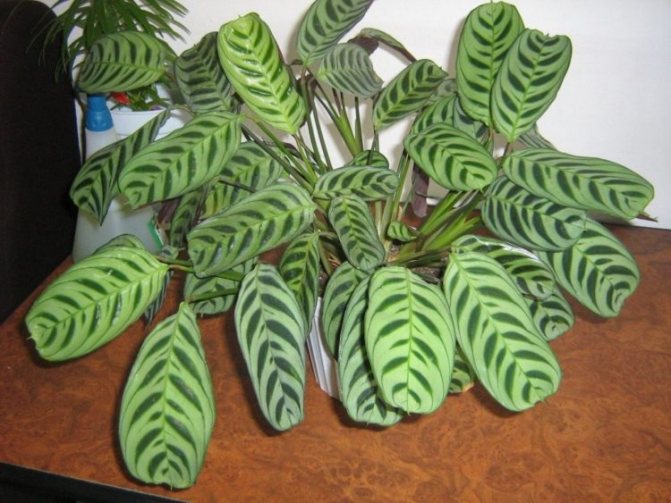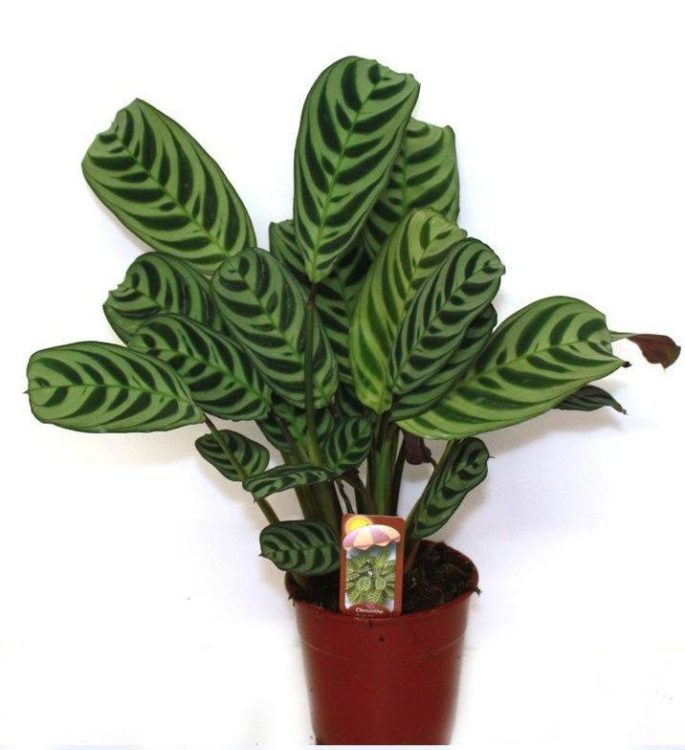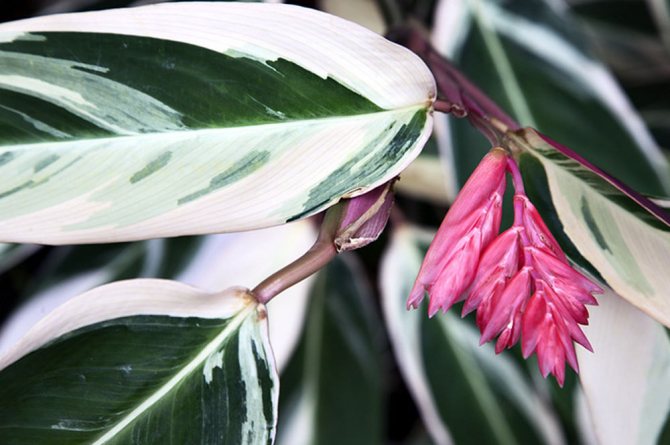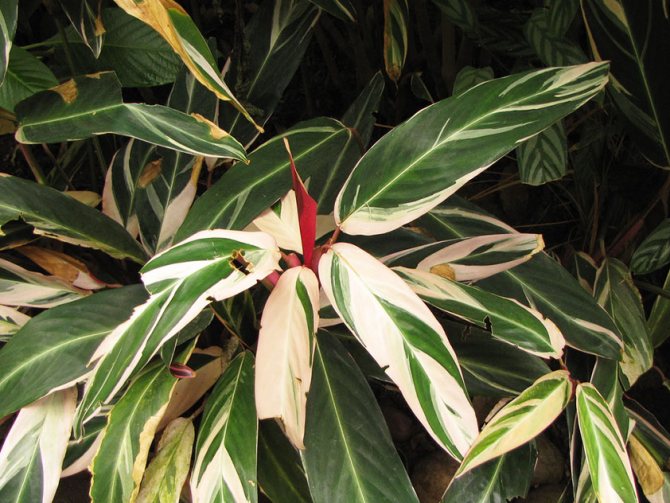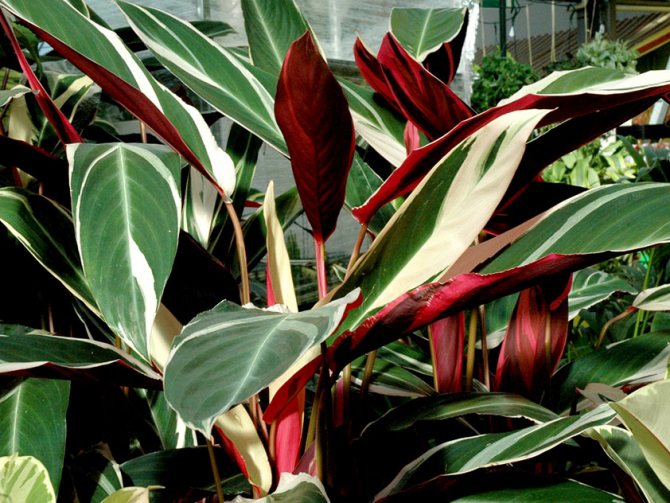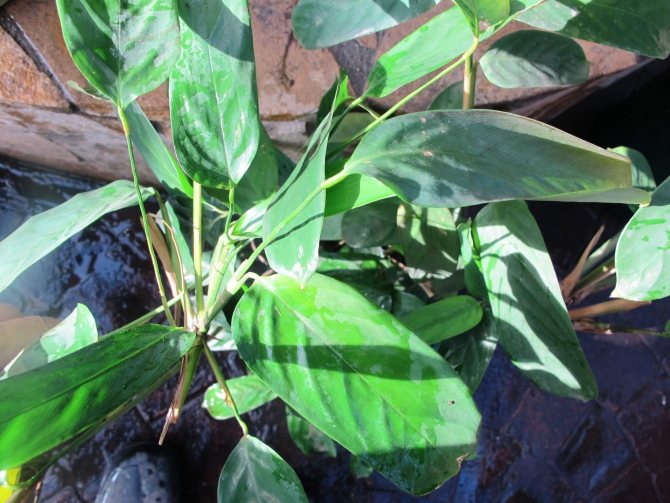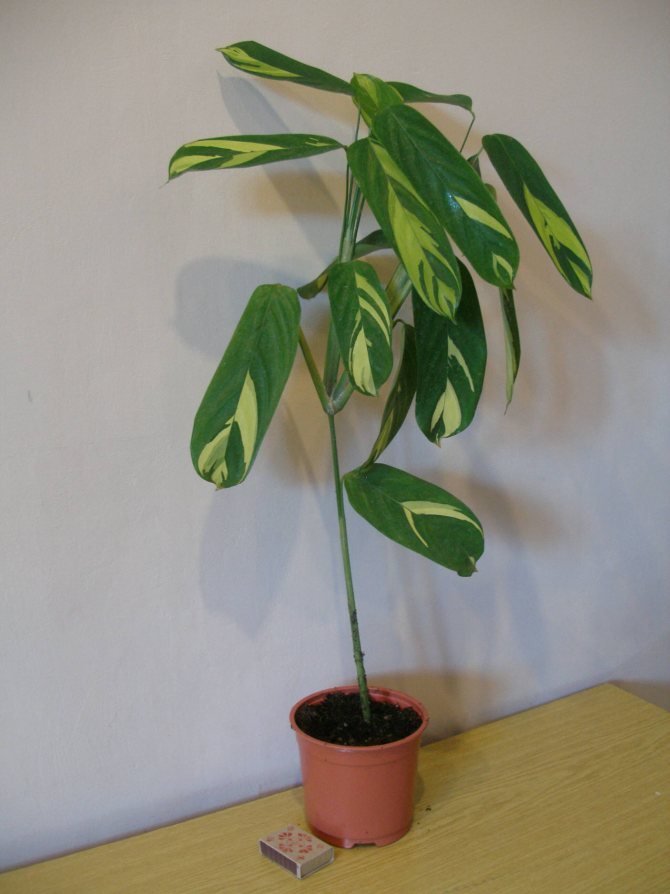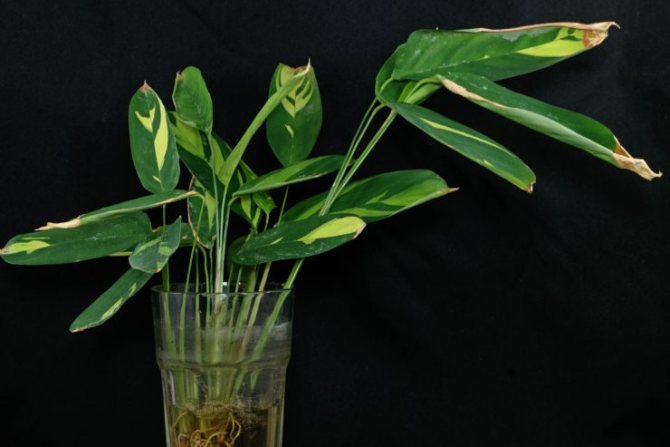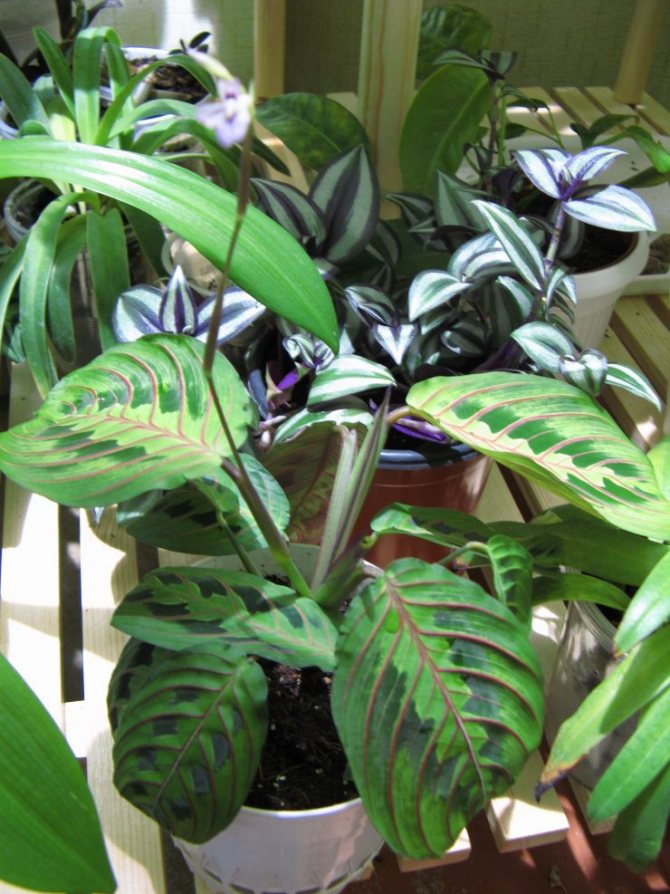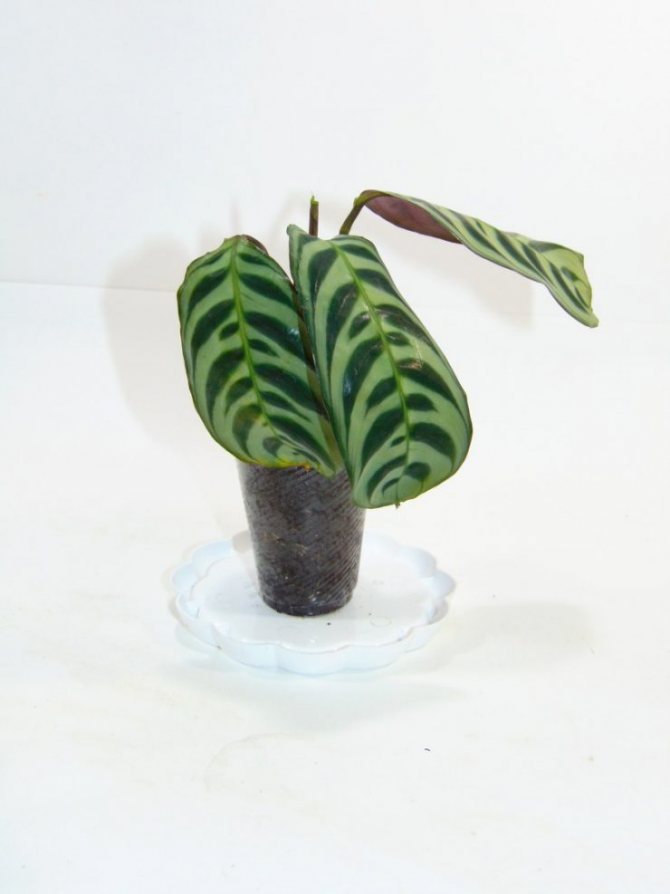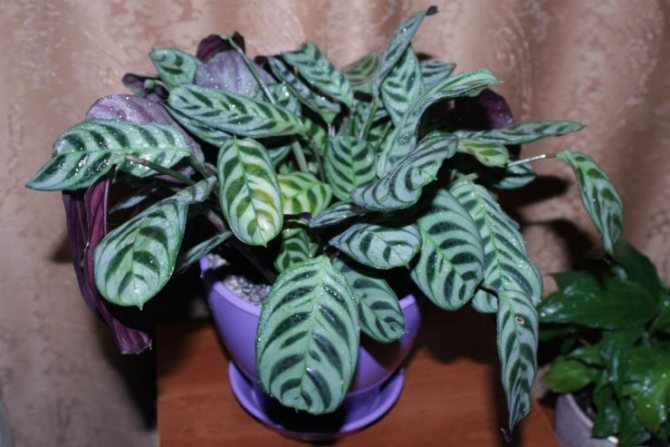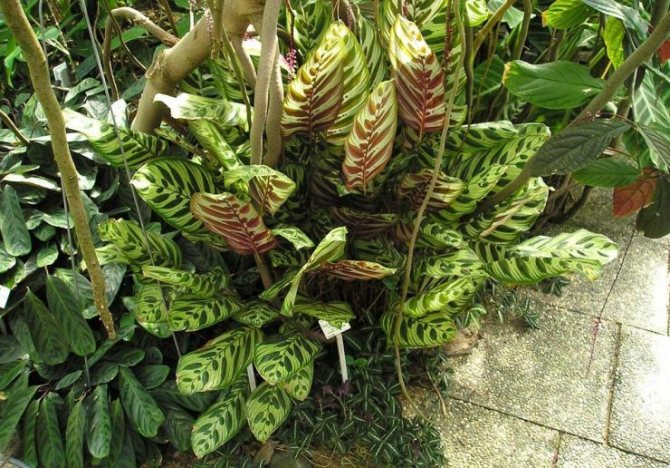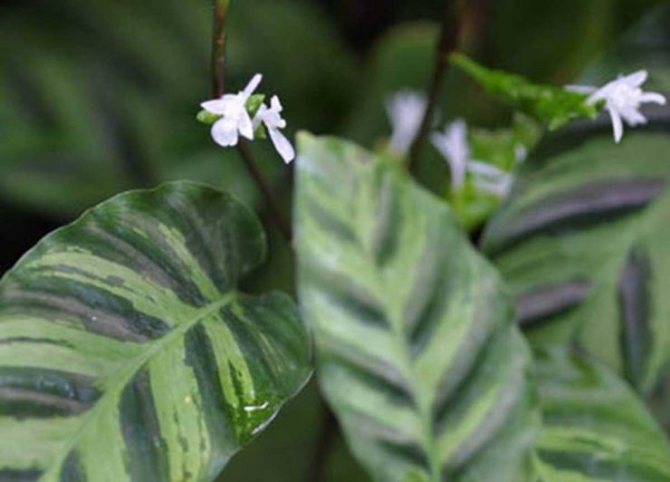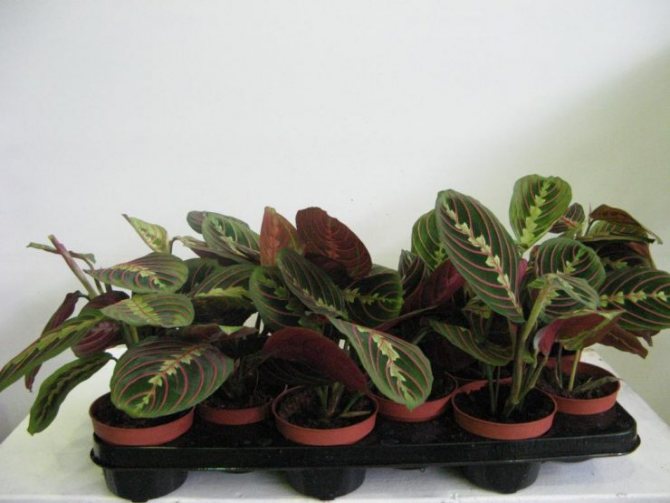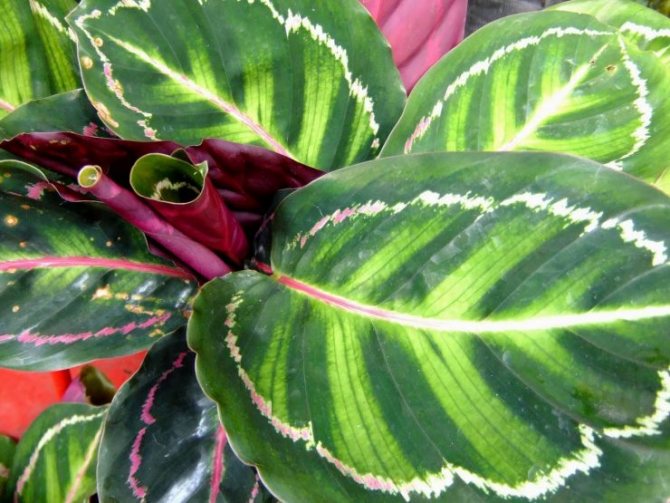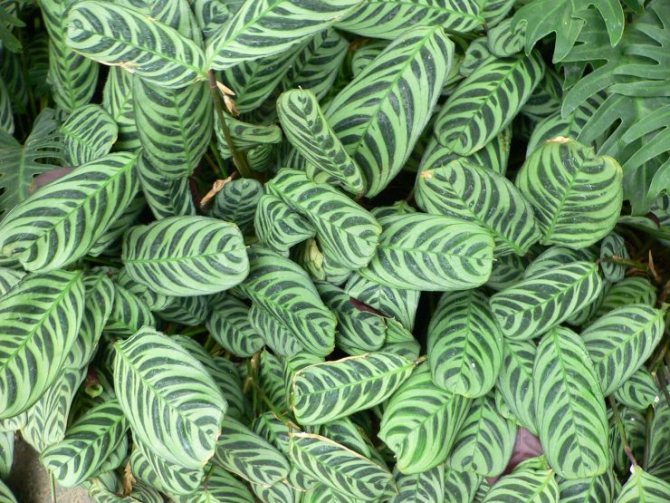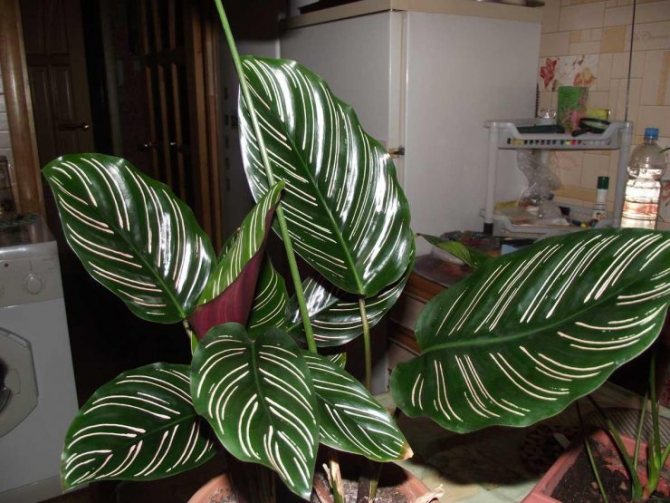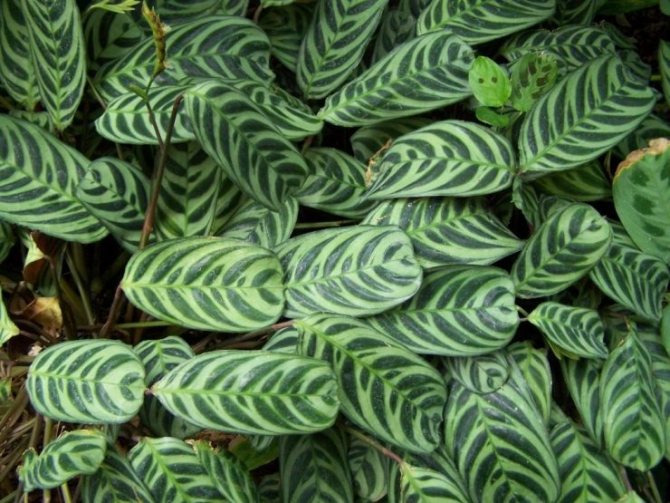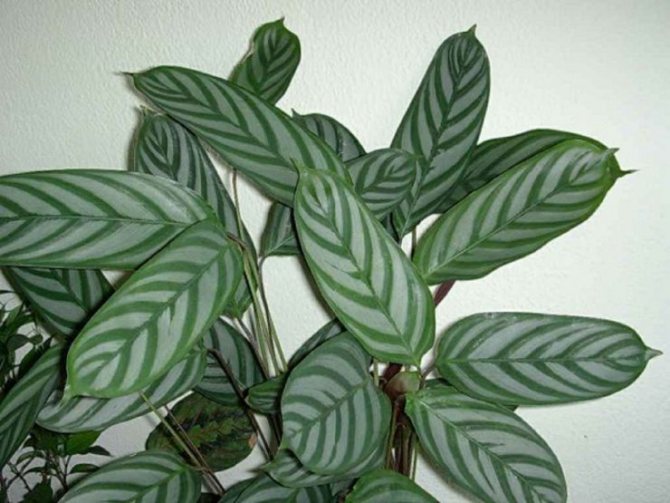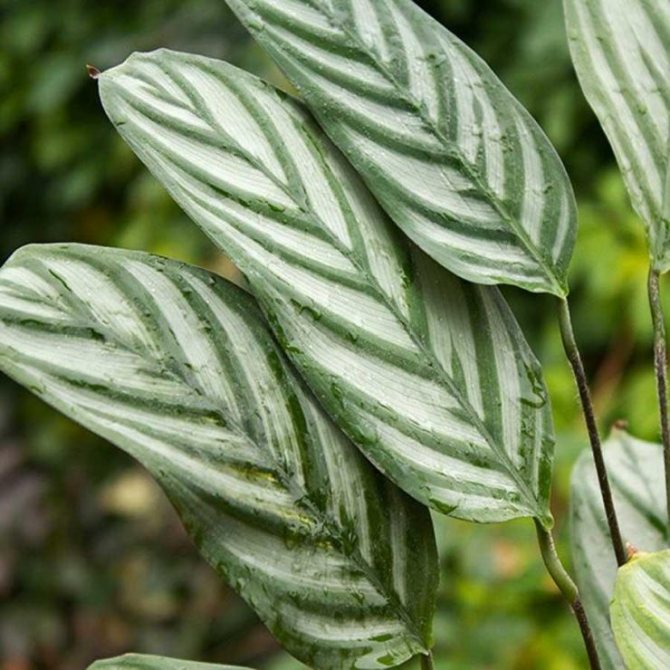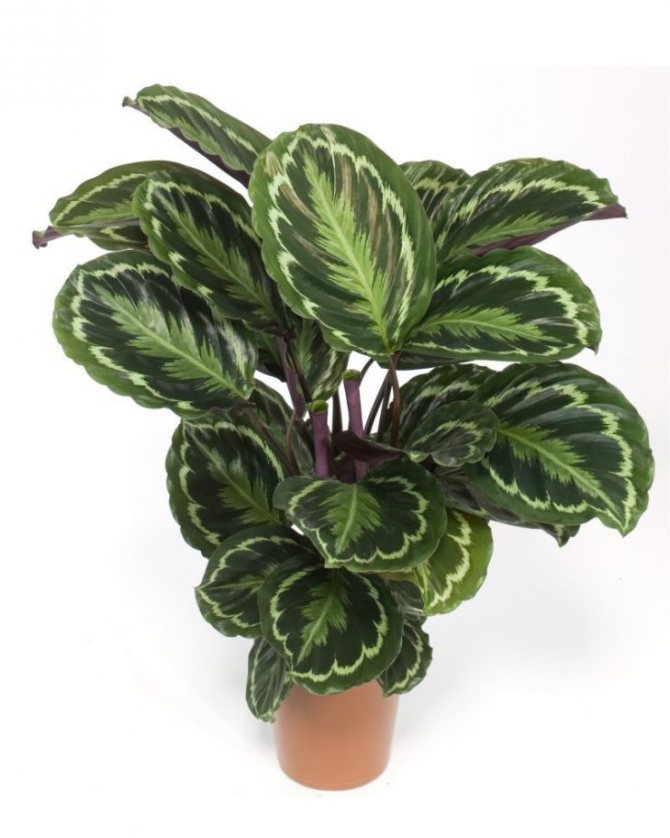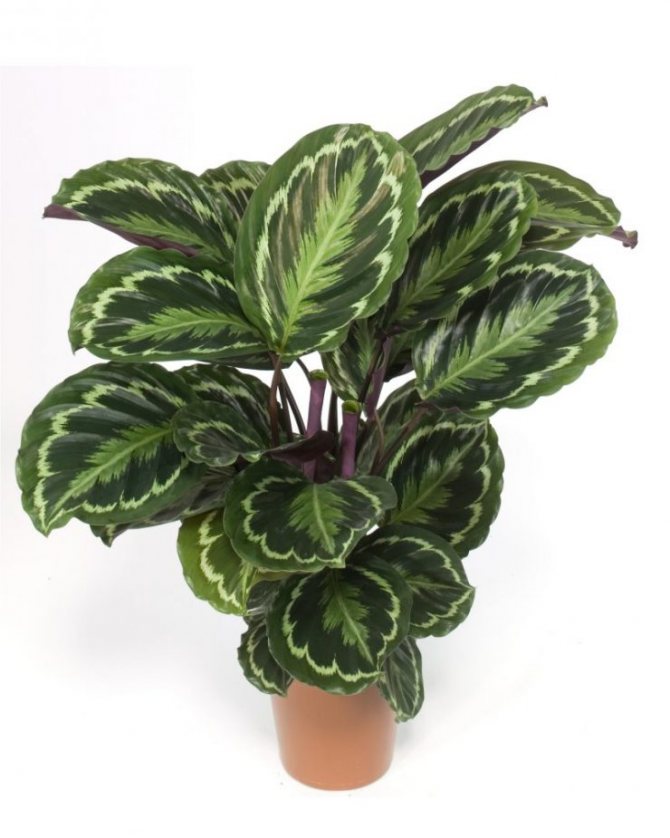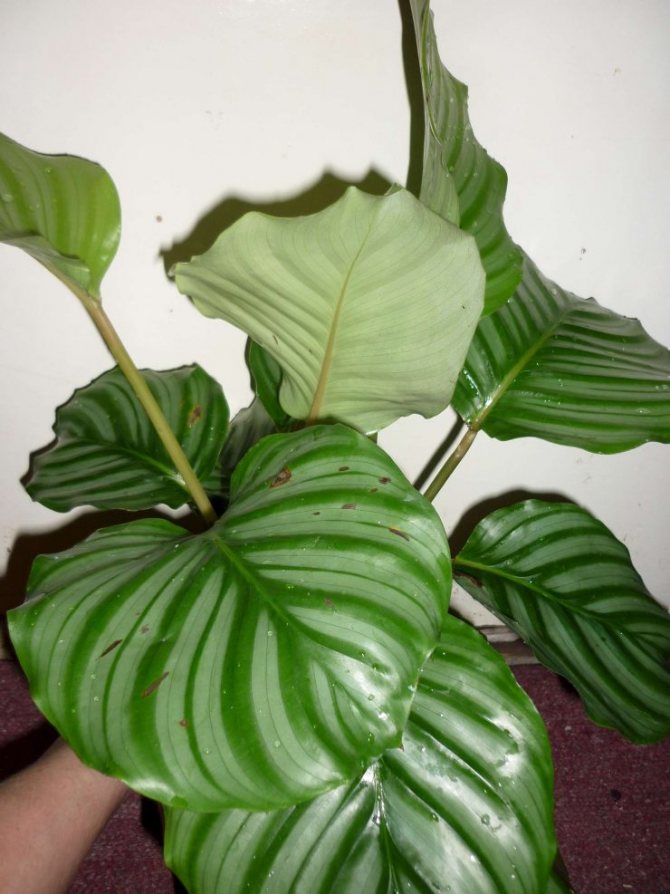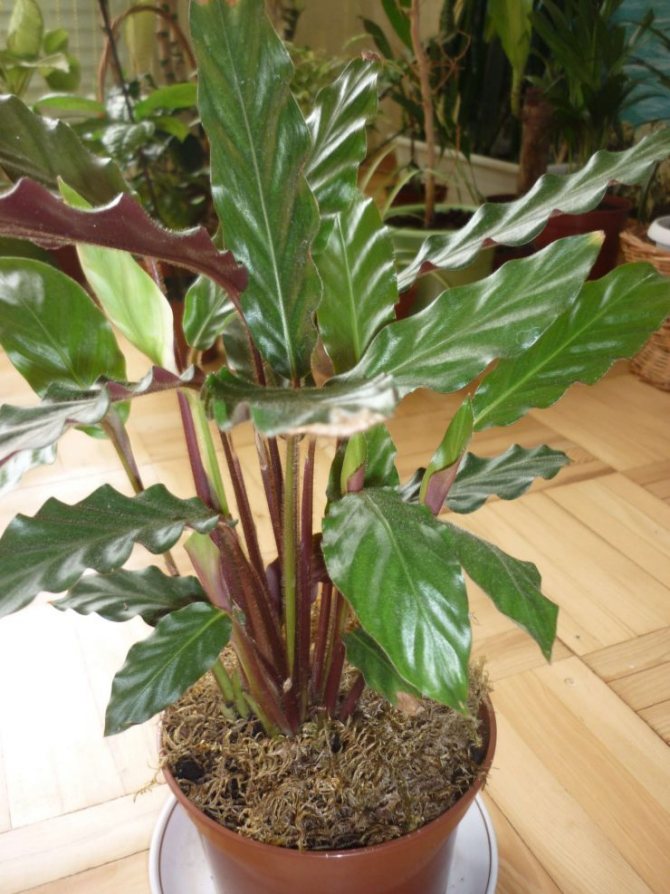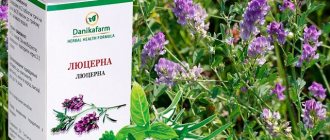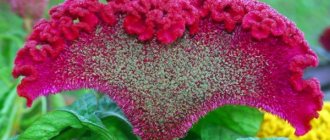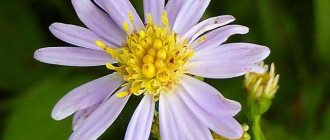Ktenanta or comb flower, belongs to the Marantov family. The forests of the Brazilian tropics are considered its homeland. The flower is unusual in that it resembles a comb with its unevenly spaced leaves on the stems. Ktenants have inconspicuous small white or pinkish paniculate inflorescences, but luxurious foliage. It is velvety and varied in color: green in different shades with randomly or symmetrically spaced stripes or spots of light tones.
Such beauty is amazing and mesmerizing. At sunset, this amazing flower raises its leaves and, rustling, folds them, as if praying. In the morning, with the first rays of the sun, the plant comes to life again: its leaves bloom again.
Photo gallery
The plant is often mistaken for arrowroot, stromant and calathea; it can be distinguished by its longer petioles and oval-elongated leaves.
Important! The plant is poisonous and dangerous to children and pets.
Problems
- If the leaves of the ktenants wilt and wilt, the problem may be insufficient watering or too low humidity of the environment;
- Small and narrow young leaves indicate a lack of light;
- Brown spots on the leaves appear due to scorching sunlight hitting them;
- The tips of the leaves dry up - which means that the air in the room is too dry;
- Leaves begin to fall off when the soil is waterlogged;
- Leaves lose their variegated color when the lighting is too bright or when too little light is provided to the plant.
Flowering and fruiting
The leaves are large, oval or oval-elongated, taper towards the base, and are asymmetrically located. Due to the short internodes, it seems that they are collected in bundles.
In the evening, the leaves close up, and in the morning they go down. Due to the long petioles and large leaves, this process is accompanied by a characteristic rustling.
The main background of the leaves is bright or light green, a pattern of light green, yellow, gray or white stripes is clearly visible on it.
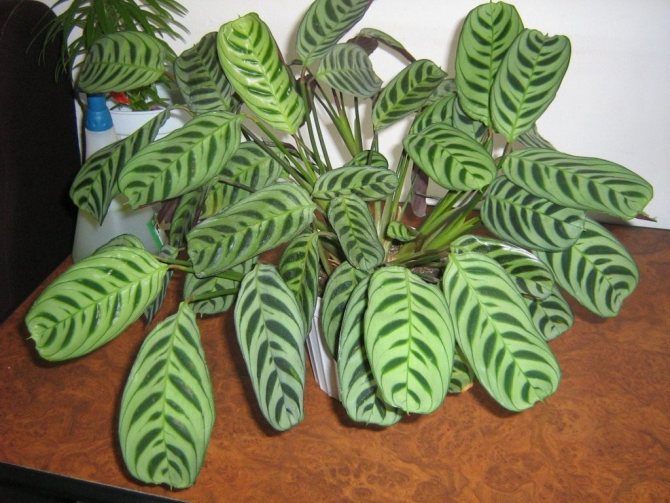
Small flowers of white-green, light pink, yellow or lilac color are collected in inflorescences-spikelets pressed against the petioles.
At home, it blooms extremely rarely.
Diseases
Of the pests, a whitefly, a scale insect, a spider mite, and a mealybug can pose a danger to ktenants.
If insects are found, they should be removed mechanically with a swab dipped in soapy water or alcohol.
In case of severe damage, it is recommended to use an insecticide - Fitoverm, Nurell-D or Aktellik.
Prevention of the appearance of pests is a regular inspection of the flower and daily spraying.
Due to excessive watering at high humidity, the ktenant can be susceptible to fungal diseases., for example, gray mold. To combat the problem, the affected areas are removed, the soil is replaced with a new one, the plant is treated with a fungicide - Fitosporin or Fundazol. Prevention of disease is moderate watering and regular ventilation.
Signs and superstitions
Ktenanta is the protector of the family hearth. Being in the bedroom of the spouses, helps to strengthen family ties, in the children's room it helps a restless child to calm down and find inner balance.
Helps get rid of fatigue and stress, create a calm atmosphere, find peace and understanding in the family.
According to Feng Shui, this is a plant with a masculine Yin energy. It is recommended to put it in a work area, a teenager's room, a place where funny and noisy companies gather.
Helps to avoid conflict situations, protects households from illness, eliminates negative energy.
Photo
Home care
Temperature and humidity
For normal growth and development of ktenants, the air temperature in spring-summer should be + 22-25 ° C, in winter - + 16-20 ° C.
Due to hypothermia of the roots, the plant may die, therefore it is important to monitor the temperature of the soil, the optimal value is + 20-22 ° C.
Throughout the year, the humidity level should not fall below 70-80%, for this it is necessary to spray the ktenant and the air around it several times a day, use a humidifier, pour wet expanded clay into the pallet, and cover the color with a plastic bag overnight.
Lighting and a comfortable place
Variegated varieties of ktenants need diffused light, species with monochromatic leaves feel comfortable in partial shade.
Important! With an excess of bright light and under the influence of sunlight, the leaves of the plant burn out.
Daylight hours should last at least 12-14 hours, and in winter additional artificial lighting will be required.
It is best to place the plant on a western or eastern window sill.
Shade tolerance
Shade tolerance depends on the leaves: the darker they are, the less light is required. However, with a prolonged lack of light, the foliage will lose its brightness, and the plant will stop growing.
Pruning
With uncontrolled growth, the ktenant loses its decorative effect: new shoots are too weak, due to lack of space, the leaves become small and turn yellow.
It is necessary to remove long shoots in a timely and regular manner and cut off limp and dried leaves, which will be replaced by new ones.
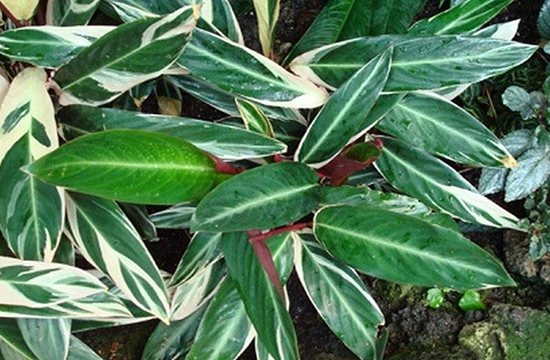

Resting care
For growth and development, a ktenant does not need a pronounced rest period. So that she has enough rest in winter, reduce the air temperature, reduce watering and feeding. Lighting requirements are unchanged.
Flower care in winter
In winter, the ktenanta does not cease to delight the grower with her beauty, but nevertheless her growth slows down, some of the leaves may turn yellow. At this time, watering and feeding the plant should be limited. When the flowerpot is on the windowsill, it is not recommended to open the window, the ktenant does not like drafts. The root system of the plant should also be warm.
To avoid hypothermia of the roots in winter, it is better to put a wooden board or polystyrene on the windowsill under the pot.
If the flower stands in the back of the room, it needs additional lighting. It can be a fluorescent lamp or a fluorescent lamp, which will help him feel good in winter.
What kind of pot do you need?
The pot needs a wide and not very high one, during transplantation, the new container should be 3-4 cm larger than the previous one. In a pot that is too spacious, water will accumulate, which will lead to the development of root rot.
The most suitable material is ceramics, due to the porosity of which it is easier to avoid overmoistening.
There must be drainage holes in the flowerpot. As a drainage, walnut or eggshells, small pebbles, gravel, expanded clay, tree bark are suitable.
Humidity
Ktenanta is a very moisture-loving plant. The optimum humidity level for ktenants is 70-90%. To create such favorable conditions, various methods should be used to increase the humidity of the environment:
- The use of a humidifier is highly encouraged;
- Place containers with water around the pot;
- During the heating season, put a damp cloth on the batteries;
- Put a flower pot in a tray filled with wet moss, pebbles, expanded clay;
- Cover the plant with plastic overnight to retain moisture.
Where can you buy? Price fork
Ktenanta is sold in online and offline flower shops, the cost depends on the size of the flowerpot, the height and type of plant and is on average 500 rubles. - 10 thousand rubles.
What to do after purchase?
A newly purchased plant should be given about 10-15 days to acclimatize. A transplant is required only in the case of a highly overgrown root system.
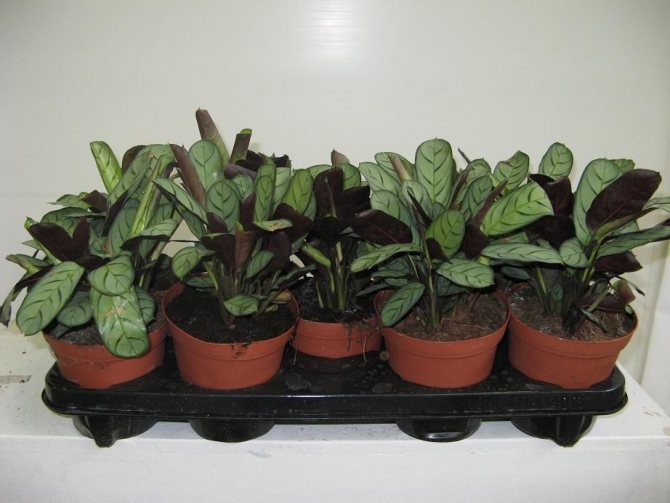

Spraying
The plant should be sprayed daily, as a last resort, every other day, in the morning or in the evening. When the moisture level is insufficient, the leaves begin to curl.
For spraying, soft settled water at room temperature is used.
An important condition: a very fine-grained spray bottle is needed, since large drops of water leave spots on the leaves, which reduces the decorative appearance of the plant.
Sometimes ktenante can arrange a warm shower... However, after the procedure, be sure to wipe the leaves with a soft cloth so that no drops remain on them.
What kind of soil is needed?
The soil should be nutritious, loose, moisture and air permeable, have low acidity (pH up to 6.0).
You can use ready-made store-bought soil intended for arrowroot or azaleas, after enriching it with charcoal, or prepare it yourself by mixing:
- 1 part sand;
- 1 part peat;
- 2 pieces of leafy land.
It is important to ensure that lime is not included in the composition of the substrate and spill it with a manganese solution or thermally treat it to get rid of pests.
Expert opinion
Mokhov Andrey Petrovich
Graduated from KubSAU specialty: agronomy
Before planting the ktenants, the soil must be checked: if, after being compressed in a fist, it remains free-flowing, you can start transplanting.
Transfer
Young specimens of ktenants are transplanted annually, adults - as needed, about once every 2-3 years, the roots will appear from the drainage holes.
The best time for transplanting ktenants is late spring and early summer.
The pot should be shallow and wide, since the southern beauty has a shallow root system. The size of the container should correspond to the volume of the root system. In a pot that is too large, the flower will not grow well.
Reproduction
Ktenanta reproduces by cuttings, dividing the bush and seeds.
For reproduction you will need:
- soil mixture;
- water;
- flowerpot;
- growth stimulants - "Zircon", "Epin", "Kornevin";
- knife;
- charcoal or cinnamon;
- polyethylene.
By cuttings
For grafting you need:
- cut branches 8-10 cm long, each cutting should have 1-2 internodes and 2-3 leaves;
- treat the sections with crushed or activated carbon and dip them in a solution of "Epin", "Zircon" or "Kornevin";
- put the cuttings in a container with water;
- when the roots grow to 0.5-1 cm, transplant into the soil, spray and cover with polyethylene to create a greenhouse effect;
- put the greenhouse in a room with bright diffused lighting and a temperature of + 22-25 ° C;
- regularly ventilate the greenhouse and water the seedlings;
- after the leaves appear, remove the greenhouse and care for the seedlings as an adult plant.
Reference! Cuttings should be harvested in late spring or early summer.
By dividing the bush
During transplantation, it is necessary to cut the roots into several parts with a sharp sterile knife so that each one has several leaves and a developed root segment.
Sprinkle the slices with chopped charcoal or cinnamon powder and dry for several hours.
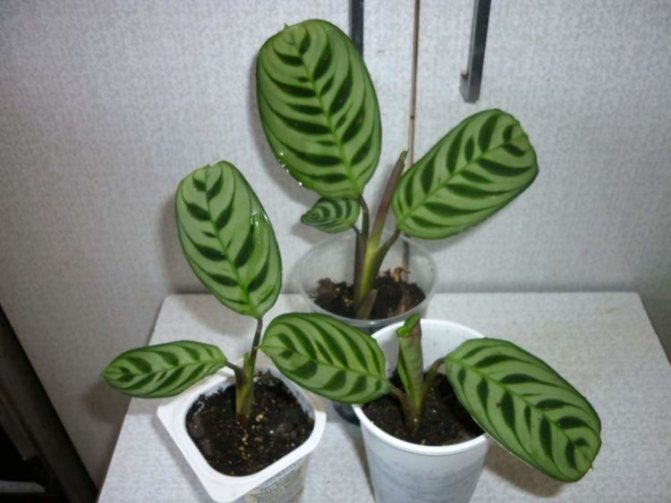

Place the delenki in separate containers, spray and cover with plastic. As the soil dries up, water with a weak solution of a growth stimulator - "Epin" or "Kornevin".
To speed up the rooting process, it is necessary to provide bright lighting, a temperature of + 25-27 ° C and use the bottom heating. In this way, only large and completely healthy plants over 5 years old can be propagated.
Seeds
Ktenanta is extremely rarely grown from seeds due to the difficulty of obtaining them at home.
For germination of seeds, it is necessary to keep them in greenhouse conditions in constant humidity, in bright light and at a temperature of at least +20 ° C, using the bottom heating.
The entrances appear after a month, after another 30-40 days they can be seated in separate containers.
How to care for a plant
Ktenanta, as a true beauty, needs a special attitude towards herself. Florists need to remember that at home, ktenants live in the humid tropics. Therefore, they place high demands on heat and high humidity. Plants are photophilous, do not tolerate deep shade.
Pot selection
It is better to grow a ktenant in wide, low pots, because the root system of this plant is superficial. It is better to use a plastic pot, as it retains heat longer than a ceramic one. There must be a drainage hole at the bottom of the pot.
Location
Bright rooms with diffused lighting without drafts are suitable for ktenants. You should not leave the pot with the plant on the south window in direct sunlight: the color of the leaves brightens and the ktenanta looks less decorative. In this case, you need to put the flower away from the window, in the far corner of the room. The culture grows well on the windowsill of a window facing east or west.
Soil and drainage
It is best to use loose, nutritious, slightly acidic soil as a soil. It can be either a ready-made mixture for arrowroot plants, or one prepared independently from two parts of fertile land, one part of peat and one part of sand. The main thing is that the soil is light, water and air permeable. There must be a drainage layer at the bottom of the pot. It can be expanded clay or any small stones.
Planting and transplanting
An adult plant is transplanted every 2 to 3 years, when roots appear in the drainage hole. When transplanting, in no case should the root collar be buried. This should be done in May or June. The pot should be slightly larger than the previous one. It is better not to transplant the flower, but to transfer it, since the roots of the ktenanta are very delicate. When transshipment, it is worth carefully examining the roots, removing the rotten ones, separating part of the overgrown bush and transplanting it into a separate pot. Then the flower must be carefully placed in a new container, all voids must be carefully filled with soil.
If the flower is tall, then you need to install a support. Then the bush will not fall apart and will keep its shape beautifully. After that, be sure to water it. To accelerate survival, you can add a few drops of a growth stimulant (Zircon or Epin) to the water.
In order for the flower to look good and not get sick, it is necessary to replace the top layer of the soil annually and loosen it slightly after watering.
The young plant must be replanted annually.
Video - transplant instructions Ktenanty:
Humidity and air temperature
The most favorable temperature regime for a flower is + 22..25 degrees with an air humidity of 70-90%. The ktenant should be regularly sprayed with soft warm water, and even twice on hot summer days. It is good if there is a container with water next to it, for example, an aquarium or a humidifier. You can put the plant pot in a gravel tray filled with water. This plant will feel good in a greenhouse, winter garden or florarium, since it is possible to maintain a constant temperature and humidity there.
Watering
The plant should be watered with warm and soft, settled water, preferably rain or thawed water. Watering should be frequent so that the plant does not dry out.If the room is very warm, then the flower should be watered about once every two days and abundantly. In the fall, the frequency of watering decreases.
Note! The soil in the pot should neither dry out nor be too waterlogged. Both of these lead to disease and death of plant roots.
Top dressing
The plant needs regular feeding. It can be any complex fertilizer. They are fed once every 2-3 weeks, strictly observing the dose indicated on the package. Fertilizer is diluted in water and watered, spending up to 1 liter per flower. In winter, the amount of dressing is reduced to once a month.
Pruning
In order for the flower to look more decorative, old and weak shoots, yellowed or dried leaves should be pruned annually. If the plant is very neglected, it can be completely cut off, placed in a semi-dark place and watered moderately. Young leaves will start growing soon.
Flowering period
Unfortunately, the flowering of this beautiful ornamental plant is not overwhelming. Ktenanta produces an inflorescence - a spikelet, on which small flowers of a white or pale pinkish color bloom. Some growers cut off the peduncles immediately, fearing that the plant will weaken. This should not be done. The stubborn flower will release a new inflorescence. Therefore, it is necessary to let it bloom for the first time, and then remove the peduncles.
Watering
In spring and summer, the plant needs to be watered approximately every 2 days, in winter - no more than 2 times a week. The regularity of watering depends on the rate of drying of the topsoil - it should dry out 1.5-2 cm deep.
Watering is carried out under the leaves, due to the ingress of water on the leaves, they can change color.
Water should be soft - rain, thawed, settled or filtered, slightly above room temperature.
If you are going on vacation
To preserve moisture during a long absence, you need to put the flowerpot on wet pebbles or expanded clay, cover the soil with wet sphagnum moss and cover the plant with a plastic bag.
Care errors and their elimination
When growing, flower growers make some mistakes that are easy to avoid:
| Problem | The reasons | Elimination |
| Leaves curl and stain | Lack of moisture | Increase the amount of watering, but so that the land is not damp, but moist |
| Leaves take on a yellow-brown hue | Lack or excess of nutrients and minerals | Transplant the plant into new soil, or change the topsoil in a pot |
| The leaves have lost their decorative effect and faded | Excessive illumination | Rearrange the plant pot in partial shade |
| Leaves fall | Dry air or waterlogged soil | Spray the plant regularly, control the watering rate |
| The leaves stopped rising | Small pot or depleted soil | Transplant the flower into a large container and replace the soil |
| The appearance of white bloom at the base of the leaves | Low air temperature and waterlogging | Move the pot to a warm place, reduce the number of watering |
| The flower grows poorly, the shoots below are dark, rot | Poor lighting, low temperature, excess moisture | Rearrange in a bright and warm place, reduce watering, transplant into fresh soil |
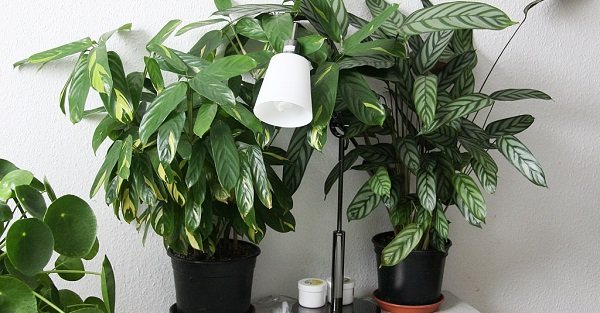

Diseases. Table
| Disease | Signs | Treatment |
| Root rot | Leaves dry and wither, roots darken and rot | A transplant is necessary with a complete replacement of the soil and removal of damaged roots, treatment with fungicides - "Alirin" or "Fitosporin" |
| Powdery mildew | The leaves seem to be sprinkled with flour | Spray the plant with a solution based on benomyl, methyl theophanate |
| Sooty fungus | Ktenanta as if covered with soot | Treat affected areas with soap |
Diseases and pests, control methods
If the growing conditions are not followed, insects may appear on its surface and in the soil, causing various plant diseases:
| Disease or pest | How to recognize | Control measures | Prophylaxis |
| Mealybug | The leaves turn pale, fall off, the appearance of white fluffy lumps in which small insects hide | Remove the pest by hand, spray with an insecticide | Regular control of the purity of leaves and stems of the plant, proper care. Careful examination of the newly acquired plant and its mandatory two-week quarantine (it is possible with preventive insecticide treatment) in order to avoid possible infection of all flowers with pests |
| Shield | Dying off of leaves, the appearance of dark plaques on them | Wash off insects with a damp sponge and soap, treat the plant and soil with an insecticide | |
| Spider mite | Leaves dry, turn white, brown spots and cobwebs appear on them | Rinse the flower with a shower, cover the soil with a film, treat with an insecticide until the pest is completely destroyed | |
| Thrips | Leaves dry up, black dots and small insects appear | Rinse the plant and treat with an insecticide until the insects are completely destroyed | |
| Decay of the root system | Withering leaves in wet soil | Dry the soil, reduce watering or transplant the plant with its treatment with a rooting stimulator | Select a pot that is suitable for the size, control the irrigation regime, monitor the temperature in the room |
| Gray mold caused by fungus | The appearance on leaves and stems of dark spots that resemble mold | Remove the affected parts of the flower, transplant it into another soil, treating it with a fungicide |
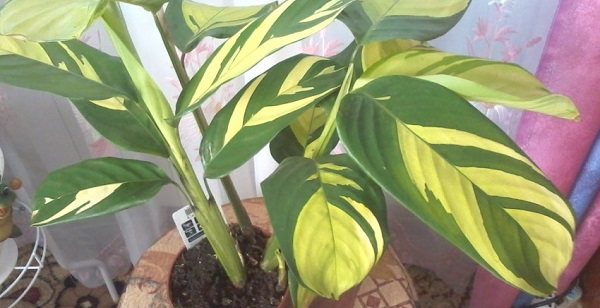

Types of ktenants with photos and names
Ktenanta refers to plants, different types of which are very different from each other in appearance.
Oppenheimiana (Ctenanthe oppenheimiana)
One of the most popular types. We love it by flower growers for an original, catchy appearance and relative unpretentiousness to care and maintenance conditions.


Leaves are oblong, narrow at the base, up to 40 cm in length, dark green with striking stripes of different colors, from light green to light silver. The inside of the leaf is magenta. The bush can grow up to 1 meter in height. A remarkable feature is the mobility of the leaves, which fold down with the onset of darkness. At the same time, a slight rustle is emitted, which can be heard in complete silence, especially if the bush is large. Looks great in the interior of any room.
Ctenanthe lubbersiana
The bush is compact, no more than 75 cm high. It differs from others in its juicy, bright green foliage and original stripes, similar to feathers of light yellow birds. The peculiarity is that the foliage retains its color in shade and even in the complete absence of sunlight, with artificial lighting.
Temperature
Ktenanta is very warm-loving. In summer, it is optimal to keep it at a temperature of 20-25 degrees, in winter - 18-22 degrees.
Ktenanta is very sensitive to cold, the temperature should not be allowed to drop below 16 degrees... The soil temperature should be in the range of 18-22 degrees, since hypothermia of the roots is fraught with the death of the flower.
Ktenanta does not react well to sudden changes in temperature and drafts, so it is better to keep her away from open windows.
Also, the plant does not like frequent rearrangements from place to place, therefore, in the warm season, you should not take it out into the fresh air.
Video review
With proper care, Ktenanta will not cause much trouble, and with its exotic look will decorate the interior of any home. In addition, there is a sign that this flower brings happiness to the house: the marriage will be stronger if this plant is in the matrimonial bedroom, and the children will sleep well and have increased attention when Ktenanta grows in their room.
Read other interesting articles on the site, for example about: clusion, clerodendrum, caladium, pteris and platycerium.
Reproduction of ktenants by cuttings and dividing the bush
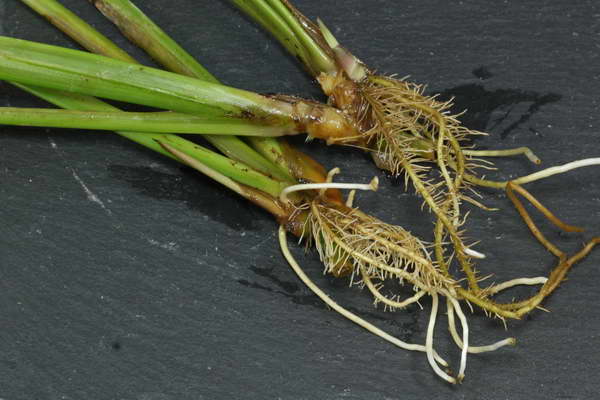

Cutting ctenants photo of rooted cuttings
Vegetative reproduction: rooting of apical cuttings, dividing the bush.
- In late spring or summer, cut the young rosette cuttings.
- Make a cut just below the point where the leaf is attached to the stem. Each stalk should contain 2-3 leaves.
- Cuttings take root in water after 5-6 weeks.
- You can root in damp soil, creating a greenhouse effect (cover with foil, jar, plastic bottle).
- Plant rooted cuttings in suitable soil.
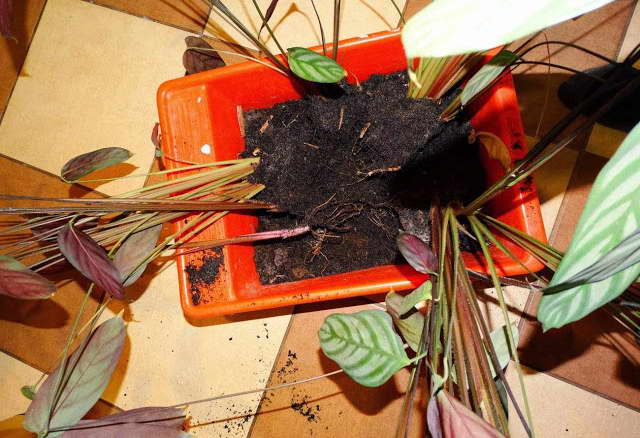

How to divide a bush ktenante photo
During transplantation, also divide the bush. The bush is divided into about 2-3 parts. Plant in nutrient soil, pour abundantly with warm water, cover loosely with a bag, keep in a warm place. When new leaves appear, the shelter should be removed.
Diseases, pests ktenants
Various pests can get to the ktenant from other plants. This applies not only to indoor flowers, but also to bouquets. To avoid infection, all new bushes should be placed separately from those purchased long ago, arranging quarantine for 3-4 weeks.
| Disease | How to determine | Decision |
| Aphid | Insects are light green or black. The posterior part of the leaf plate of young shoots is affected. |
|
| Shield | The appearance of growths on the entire surface of the plant. Around the affected areas, the flower turns yellow. |
|
| Mealybug | Stains like flour marks. The foliage begins to turn yellow, the affected areas dry out. |
|
| Whitefly | Flying pests of white color. They take off if disturbed by hitting a flower. |
|
| Spider mite | Cobweb on the stems, brown spots with a yellow halo on the back of the leaf plate. |
|
| Root rot | The development of mold in the soil, the appearance of an unpleasant odor, the spread of brown and black spots on the lower part of the stems. |
|
Air humidification
A photo of a ktenanta, grown in good conditions, shows a beautiful, lush bush with bright leaves. But in reality, we can often face the fact that the leaves begin to shrink, become faded, and the drawing almost completely disappears. Why is this happening? The most common problem is the excessive dryness of the air. Most often, it is with such a question that novice florists turn to specialists. Why did Oppenheim's ktenants curl up the leaves? This variety is very picky about the level of humidity in the air. In addition to drying out the tips of the leaves, usually the plant's immunity is also reduced, and it becomes a victim of pests and diseases.
So, watering alone will not solve this problem.Bathing a flower under a warm shower has a positive effect on growth and development. Make sure that no water remains on the leaves. To increase the moisture level, you can place the plant pot in a tray and fill it with damp moss or gravel. But the roots should not constantly touch the water. Usually, this measure is sufficient for young leaves and healthy root shoots to appear.
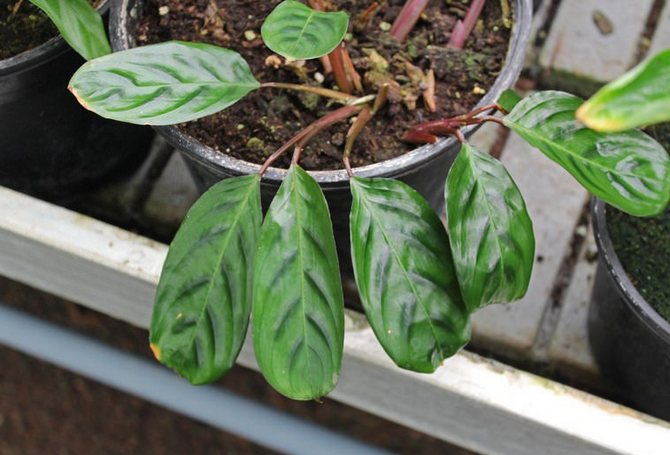

1. Seven Secrets of Success:
| 1. Growing temperature: throughout the year - the usual room temperature is in the range of 18 - 24 ° C. |
| 2. Lighting: for ktenants, direct sunlight is permissible on the flower in spring and summer during the morning and evening - sufficient lighting is necessary to maintain the bright color of the leaves. In the daytime, it is better to shade the plants. |
| 3. Watering and humidity: the soil should be evenly moist during active growth and flowering, in autumn and winter, the frequency of watering is adjusted to the temperature in the room. Air humidity is high. |
| 4. Pruning: sanitary and formative - at the end of winter. Also, timely pinching of the apical buds of young shoots to maintain a compact form. |
| 5. Priming: based on peat, leaf humus and sod land, nutritious and loose, should have a slightly acidic pH. |
| 6. Top dressing: twice a month during the spring and summer with fertilizers for decorative foliage plants. In winter, the frequency of dressing is reduced to 1 time per month. |
| 7. Reproduction: by cuttings or dividing in the spring transplant. |
Botanical name: Ctenanthe.
Ktenant plant - family... Arrowroot.
Homeland of the plant... Central and South America.


Description. Ktenanta - a small genus, consisting of 15 species of evergreen herbaceous perennials. Leaves are oval or lanceolate, up to 20 cm, on long petioles, collected in rosettes. The color of the leaves is highly variable and depends on the specific species - from monotonous green to green with various, often symmetrical spots and stripes of silver or yellow. There are varieties with burgundy leaves, as well as tricolor - when the underside of the leaves is painted in a red or burgundy shade. In appearance, the plant often resembles a related arrowroot. The flowers are white or yellow, hidden by green bracts, small and inconspicuous, lost against the background of foliage.
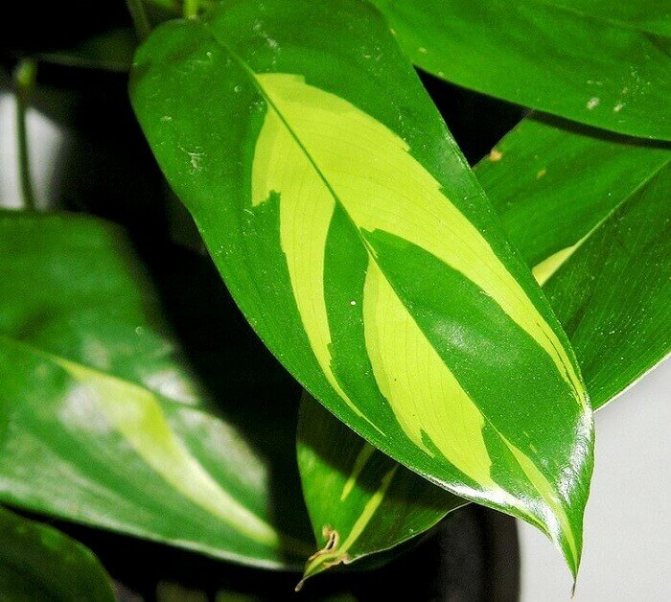

Height... In indoor conditions, the height of the ktenants ranges from 60 to 90 cm and rarely exceeds 1.5 m.
Transplant ktenants
The frequency of transplantation varies from 1 time in 3 years to annual, depending on the age of the nurse. When replanting, the soil should be replaced. It is imperative to prune old leaves when transplanting.
Why do ktenants dry turn yellow and curl leaves
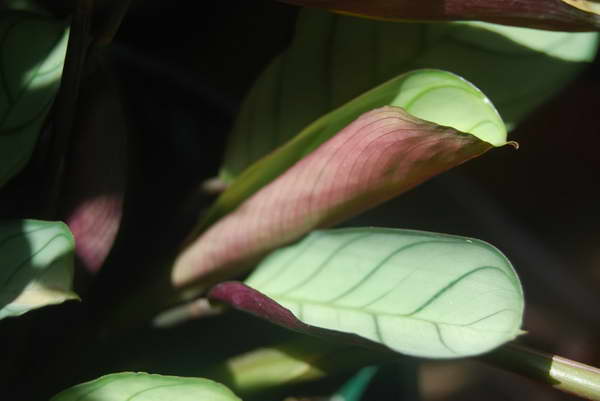

Ktenanta dry and curl leaves photo
The sickly look of the plant is caused by mistakes in care:
- Low air temperature combined with high humidity causes the stems to wither and rot. It is necessary to remove the affected areas, treat with a fungicide;
- From dry air, the leaves slow down growth, the tips of the leaves dry;
- Excess or deficiency of nutrients: the tips of the leaves turn yellow-brown;
- From insufficient watering, the leaves curl up, brown spots appear;
- From too intense lighting, the leaves fade;
- Dry air or excessive watering leads to leaf fall;
Leaves dry out, curl and turn yellow in case of violation of the correct regime of detention. Be careful: a lack of moisture in the leaves, which causes them to curl, is not always a sign of insufficient watering. It is possible that you even flooded the plant, from which the roots suffered and began to rot, due to which the above-ground part of the plant began to lack moisture.
Make sure that there is no stagnant moisture in the soil and that the earthy ball has not shrunk enough to keep water out. Only you yourself can determine the cause of the ktenante's painful condition.Often, a transplant is required with mandatory inspection of the roots, soil replacement and treatment with a fungicide (phytosporin). Further care should provide the plant with moderate moisture without frills.
Pests
Possible pests: mealybug, spider mite, whitefly, scale insect. Remove them mechanically first. Moisten a cotton pad with soapy water and wipe the leaves. Then carry out the treatment with an insecticide, repeating it after 5-6 days two or three times.
Varieties of ktenants
Ktenant Lubbers. Bred in Brazil. Plant length up to 2.4 dm. Green leaves with white to yellow veins. The leaves are ovoid, the end is truncated.


The height of Ktenanta Oppenheim reaches up to 9 dm. The leaves are similar to those described above, but the front side of the leaf is velvety, on the back the leaf is purple.


Ktenanta compressed is the smallest species of this family. The plant grows east of South America, mainly Brazil. It is mainly used as an ornamental indoor plant. Maximum sheet length - 1 dm, width - 4 dm.
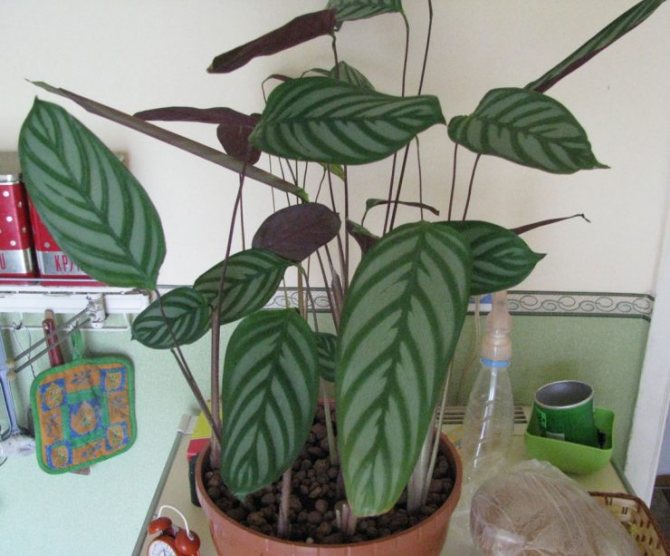

Planting a plant: soil, pot, drainage
Young ktenants recommend replanting annually, adults - on demand, when the roots have no room for development and the plant has stopped growing. The transplant is carried out in the warm season: in May or June. Usually, this operation is combined with the reproduction of the plant by dividing the root.


This ktenanta may have grown out of her pot and needs a transplant.
A newly purchased flower should be transplanted after keeping it in quarantine for a couple of weeks. In stores, they are kept in a depleted substrate to limit growth. Therefore, try to remove almost all of this soil, but you do not need to rinse the roots so as not to injure.
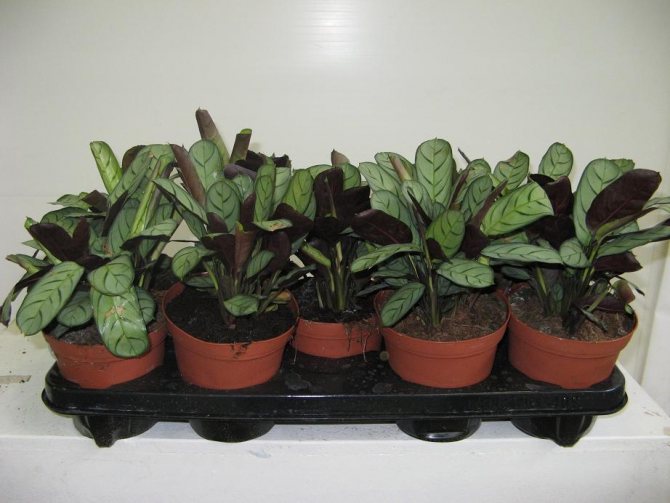

After purchase, give the flower time to get used to and keep it in quarantine, and only then transplant
A wide plastic pot, slightly larger than the previous one, is suitable for Ktenante. It is not worth taking too voluminous, undeveloped land easily sour. The plant has superficial roots and does not need depth. And plastic, in comparison with ceramics, retains heat better - this will appeal to a southerner-ktenante.
The tropical beauty will be grateful for the nutritious, loose and slightly acidic soil. Formulation options:
- ready-made store mix for arrowroot or azaleas, enriched with crushed charcoal;
- on 3 parts of garden land, one and a half - peat and one sand;
- equally divided humus, leaf and peat soil with the addition of a small amount of coniferous soil and pieces of charcoal;
- on 2 parts of leafy land, one - peat, half a part of humus and sand, for airiness cut sphagnum moss and pine bark;
- equally divided leafy soil, peat, sand and cut moss;
- universal soil, 1/3 of the soil for cacti;
- peat substrate, compost and leafy soil in equal proportions.
Test the soil medium the day before planting. Squeeze a handful of soil in a fist, hold for a minute, and then unclench. The substrate crumbled easily, which means that the mixture is prepared as it should.
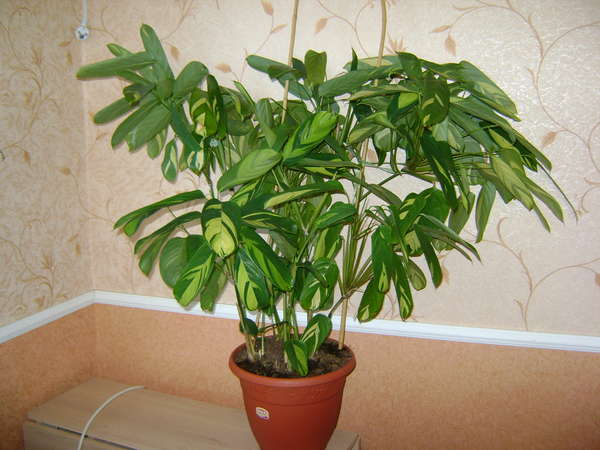

A large pot is not needed even for a tall ktenante, she has a very modest root system
We transplant the ktenant
- Sterilize (ignite or steam) the potting mix and drainage, scald the pot with boiling water.
- Put a drainage layer on the bottom of the pot (large expanded clay or broken brick mixed with river sand), it should take about ¼ of its volume.
- Pour some soil on top of the drainage, moisten it.
- Carefully remove the plant from the old pot without breaking the root ball.
- Examine the aerial part, remove dried and diseased leaves.
- Examine the roots, if there are rotten ones, carefully remove them. Separate part of the bush for propagation, if necessary.
- Move the plant to a new pot.
- Gradually fill the earth ball with new soil, compacting the void between it and the wall of the pot. Shake the container slightly in the process so as not to leave empty areas.
- Water the plant lightly, spray it and place it in a slightly shaded place.
Ktenanta, like other arrowroots, painfully tolerates the change of the pot. To help her, add a rooting agent (root, zircon, eco-gel) to the irrigation water once a week. It can be sprayed from a very fine spray with an epin solution (2-3 drops per glass of water).


After transplanting, support the plant with stimulants.
About support
Most ktenants are tall plants. Very large leaves are located on long, sometimes more than a meter, and thin herbaceous shoots. Therefore, over time, the bush can fall apart ugly. To keep the ktenant in shape, install a support in the pot. This can be a design from a store or one made by yourself. For example, place bamboo sticks around the circumference of the pot and connect them with flexible wire or string. Ktenanta leaves do not need heavy-duty support, they are quite light. The main thing is not to allow the shoots to deviate from the vertical.
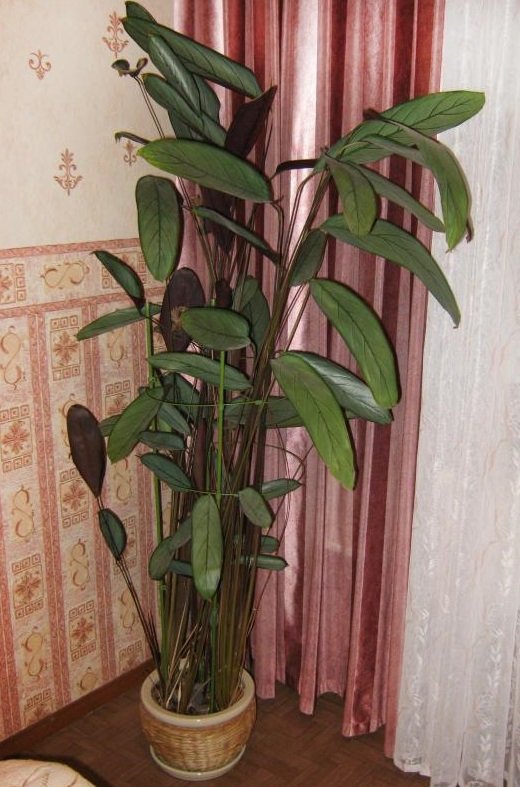

It will be more comfortable for taller ktenants to hold the leaves if you install a support
Names of species and varieties: ktenant Oppenheim, Burle-Marx, Lubbers and others
The genus ktenanty has about 15 species. In indoor floriculture, five of them have become widespread, as well as varieties bred by breeders.
- Ktenant Oppenheim is the most popular and tall (over 1 meter) species. Small-fleecy and large (about 45 cm) leaves have the shape of an elongated oval with a sharp end. They are located on tall petioles and are decorated with light green, silvery or cream stripes. The underside is purple colored.
- Tricolor (Tricolor) - a form of Ktenant Oppenheim with even more variegated leaves. They combine different shades of white, pink, green.
- Ktenanta Lubbers is a well-known species in home floriculture. The height of the bush can reach up to 80 cm, but there is also a low-growing form - about 30 cm. The leaves are painted on top with a yellow pattern along the green field. The wrong side is light green.
- Ctenanta Lubbers Brazilian Snow is marked with cream-streaked leaves. They are very wide and can take up to half of the leaf plate.
- Ktenant Burle-Marx is a compact species, no higher than 40 cm. The oval leaves without sharpening are painted in different tones of greenery, from silvery-greenish to dark marsh. The spots are not scattered chaotically, but create an ornament. The reverse side of the leaf plate is wine-burgundy.
- The Ktenanty Burle-Marx Amagris variety is an even smaller bush, no more than 30 cm. The silvery-green leaves are decorated with contrasting veins on top. The reverse side is light purple.
- Ktenanta pubescent (or bristly) is very similar to Ktenant Oppenheim. But the growth is slightly lower - about 80 cm. The leaves are wider at the base, and the decorating stripes on them are narrower than those of Oppenheim's ctenants. But the main difference between the pubescent variety is that the petioles are covered with small villi.
- The pubescent ktenanta of the Gray Star variety is distinguished by pointed leaves of a bluish tint, a pattern of dark green color is traced along the veins. The underside is wine purple.
- The compressed ktenanta is also a tall species, about 1 m. There are four leaves on the tops of smooth shoots. They are shiny and not so variegated as compared to other ktenants. Leaf plate in different shades of green.
- The arrowroot ktenantha is a species that used to be called Ctenanthe pilosa. Differs in elongated oval leaves (about 20 cm long). The main color is dark green, the spots are yellowish-lime.
- The pleasant ktenanta (amabilis) prefers to develop in breadth rather than upward, like arrowroot. Leaves are oval-elongated, silvery-green. Florists note that this species prefers more abundant watering than others.
Varieties of ktenants in the photo
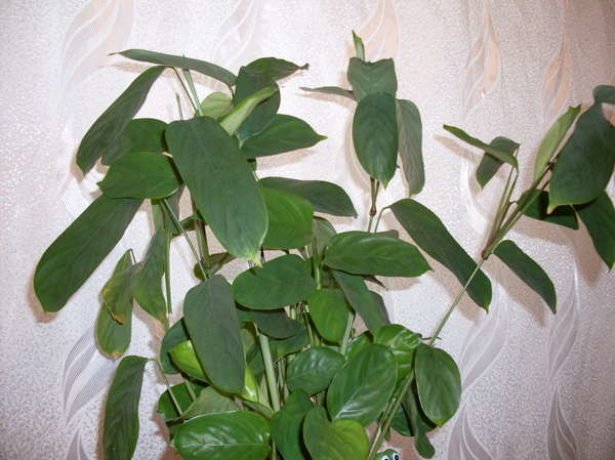

Ktenanty compressed leaves are sustained with green tones
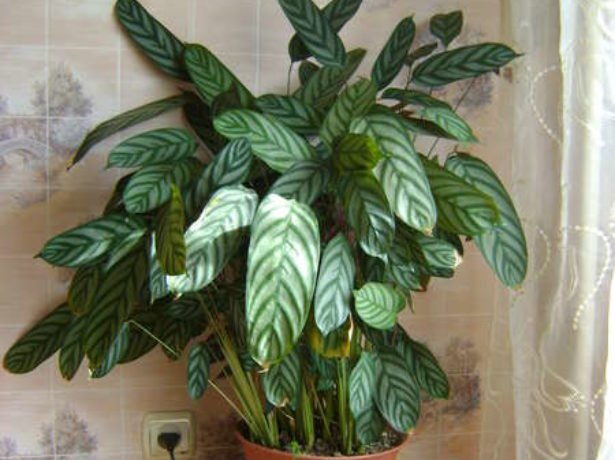

Ktenanta pubescent differs from others in fleecy shoots


Pleasant ktenanta forms whole deciduous "pillows"
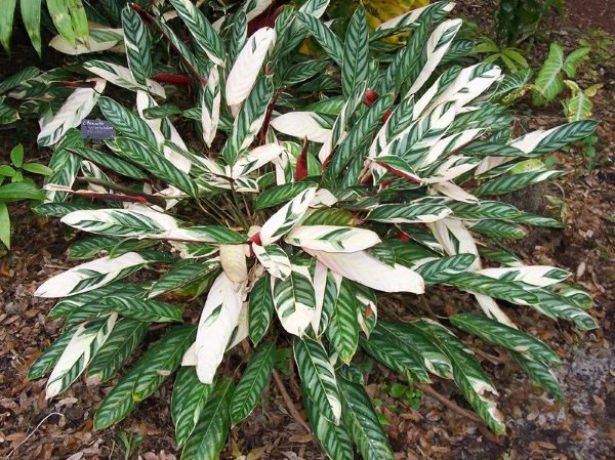

The Tricolor variety has richly colored leaves
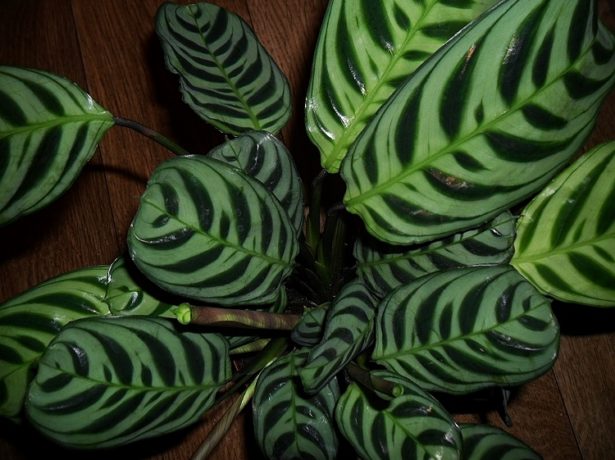

Ktenanta Burle-Marx is a compact bush with wide oval leaves


Leaves of ktenanty Lubbers with green-golden painting
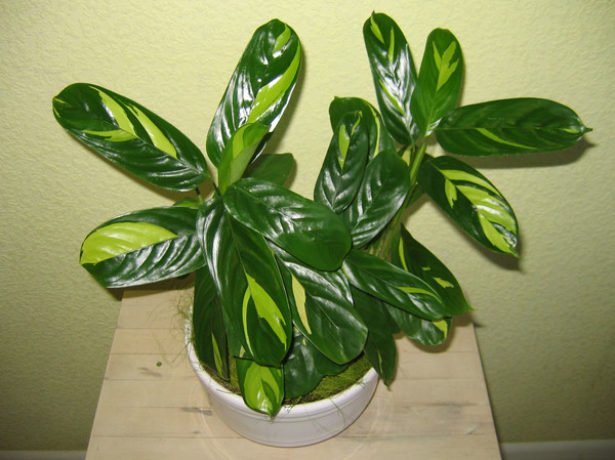

On oval leaves, light green stripes and spots


The original form of Oppenheim's ktenants has leaves with a green pattern on top and a purple bottom.


Amagris is the smallest bush


Brasilian Show has wide, creamy stripes
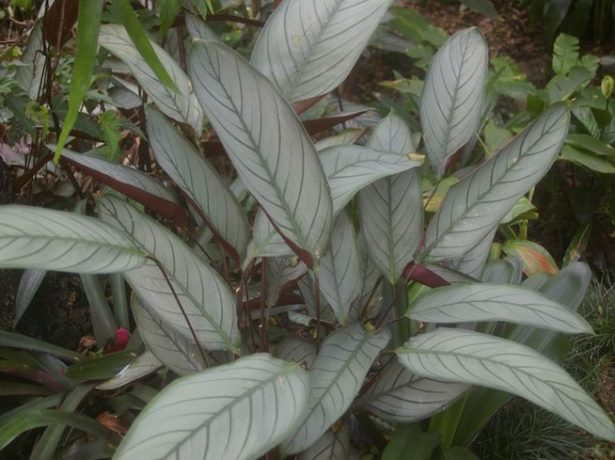

Gray Star has elongated silvery-green leaves
Video: acquaintance with a pubescent ktenant in the natural environment
Myths about the ktenant
Popular rumor describes the ktenantu mainly as a plant favorable for growing at home, although it is often spoken of as a flower with an ambiguous energy. And yet, in general, the most often attributed to the comb flower is the magical power of protecting the house from evil forces, strengthening mutual love between spouses, calming, relieving stress, improving sleep and even treating lingering illnesses.
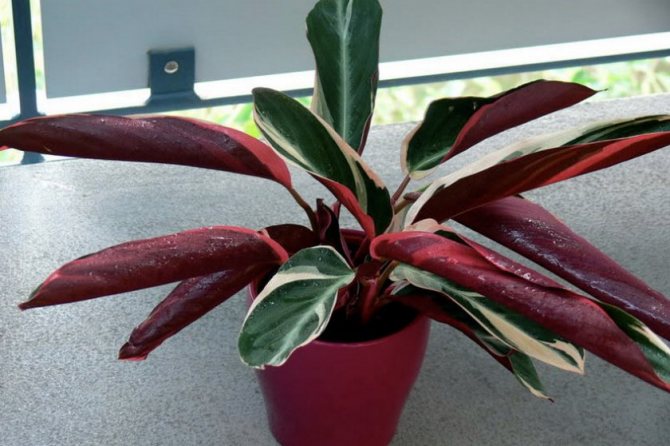

Plant specialists are sure that the ktenant can be safely placed both in the nursery and in the matrimonial bedroom, as well as in the room where the elderly person lives. From such a neighborhood, the condition and mood of the household will only improve.
Crocodile leaf is a very elegant plant, but, unfortunately, it is difficult to attribute it to unpretentious. Caring for such an indoor flower involves the creation of conditions that are not entirely compatible with the living space (mainly it concerns air humidity), however, placed in a decorative florarium, Ktenanta will become a real decoration of the home, filling it with comfort and positive energy.
Botanical description of the plant
Ktenanta is a very popular houseplant, prized primarily for the unusual color of the leaves; it is not for nothing that it is often called a comb flower or crocodile leaf. The homeland of this unusual evergreen perennial belonging to the Maranta family is the hot tropics of sunny Brazil, but the plant is also found in some regions of Central America, in particular, in Mexico and Costa Rica.
| Maximum dimensions | Up to 2 m |
| Root system | Rigid, highly branched, fibrous |
| Stem | Herbaceous type, thin |
| Leaf shape | Asymmetrical, not carved, in the form of an elongated oval with an extended bottom, they are collected in dense tiers, very close to each other so that they look like bunches |
| Leaf size | 20-40 cm |
| Leaf color | Green in various shades with decorative stripes, streaks or blotches directed from the center to the edges |
| Leaf structure | Soft |
| Inflorescence | Ear |
| Flowers | Bisexual, small, devoid of decorativeness, covered with dense bracts |
| Fruit type | Box |
| Fruit taste | The fruits are not edible |
What is a plant
Ktenanta is a perennial plant, represented by a shrub no more than 1 m high (in nature, 2.5 m are found).
On small stems there are elongated cuttings that hold voluminous leaves, reaching 20 cm in length and arranged asymmetrically, gathering in small internodes. Plates are oval or oblong in shape, with irregular patterns or in the form of a precise geometric figure.
On plain leaves there are pronounced streaks, more often of a burgundy color.
The root system of the flower is delicate and is afraid of hypothermia, which should be taken into account when keeping a representative of the flora.
At home, the plant very rarely throws out a peduncle. Due to the lack of flowers, flower growers do not worry, there is nothing beautiful and unusual in them, and are characterized as small white nondescript flowers. The close location to the stem merges them with variegated leaves.
Plant care
Ktenanta is a rather whimsical plant that requires special attention and respect.
The first feature is the temperature regime, for spring and summer it should not exceed 25 degrees, and in winter no more than 20.The ground temperature is from 20 to 22 degrees, in order to avoid hypothermia of the roots.
Further, it is necessary to closely monitor the air humidity, the minimum component of which is at least 65% all year round. To maintain this figure, you need daily spraying or a humidifier.
Experienced flower growers use a pallet with moistened expanded clay and nightly wrapping the plant in a plastic bag.
Owners of this "green pet" must also observe the lighting order, which differs for a flower with a monochromatic appearance of leaves or variegated. Having one shade of plates, the plant can be placed in partial shade, others - under diffused light. Direct sunlight is dangerous for the plates, they cause burns and areas of burnout.
If on summer days there is enough light illumination, then for winter it is necessary to install additional equipment in order to provide the plant with at least 12-14 hours of daylight hours. The best location for the pots is a window sill on the west or east side.
On a note! The darker the leaves of a plant, the less light it needs. A lack of consecration will be indicated by a faded color and a stunted growth.
To enhance the vitality of the plant, fertilizing is necessary, which is carried out 2 times a month from April to August. For cold weather, once every 4 - 6 weeks is enough.
When purchasing ready-made fertilizers, it is better to use complex fertilizers for indoor decorative deciduous plants. When mixing the mass on your own, you should avoid high content of calcium, nitrogen and organic matter.
Cutting of new organs is used to strengthen the stem and shoots. If Ktenant has long shoots, lethargic or dried leaves, they must be removed so that the plant does not waste its energy on restoring or maintaining the vitality of these parts.
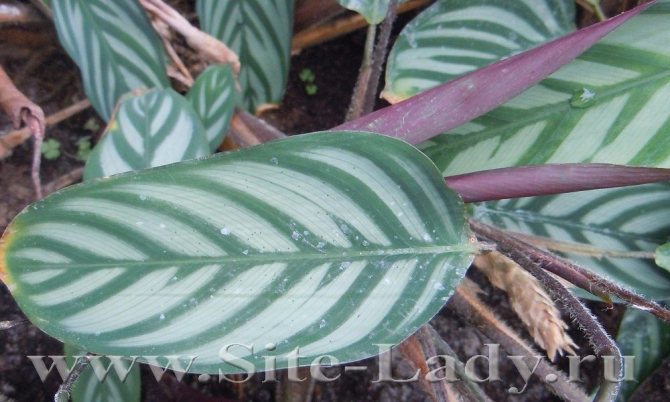

When caring for a whimsical plant, you should also pay attention to the pot chosen at each transplant and corresponding to the root system (no more than 3-4 cm on either side of the roots). A narrow pot interferes with the full growth of leaves and may cause them to turn yellow.
In addition, the pots should not be wide and high, as this will provoke water accumulation and rotting of the roots. When choosing a flowerpot, attention is paid to the drainage holes at the bottom, their presence is required.
The soil should not dry out more than 2 cm in depth, therefore, in summer, the cover is irrigated once every two days, and in winter, twice a week. The introduced moisture should not get on the leaves, watering under the plate, preserving the decorative ability of the flower.
The water should be at room temperature or slightly higher. Only settled and filtered liquid is suitable.
Ktenante does not have a pronounced resting phase, but in order for the plant to gain strength, the temperature decreases in winter, watering and feeding.
A flower purchased in a store needs adaptation within 10 - 15 days. After this period, it is better to transplant a representative of the flora into the soil for arrowroot flowers, which contains the required ratio of lime.
Treatment with a manganese solution or heat treatment will positively affect the plant.
After changing the soil, the flower is very vulnerable and afraid of sunlight. Watering is carried out only on the fifth day, fertilization occurs in a month.
If the rules of care are violated, the plant is susceptible to diseases (root rot, powdery mildew, sooty fungus) and pests (spider mites, scale insects).
Leaves curled up in a tube, their rotting, discoloration or spots, as well as rotting stems, will allow to respond in a timely manner to deviations in the handling of a flower. In the presence of all these unpleasant factors, it is necessary to monitor the level of humidity, lighting, the presence of drafts and temperature.
Positive signs
Ktenante is a pleasant plant with decorative leaves, without negative signs or beliefs.However, the flower is glorified for its magical abilities in relation to the family hearth.
The presence of a pot with a "green pet" in the bedroom will allow married couples to find understanding, love and tenderness.
The plant will help regain lost attraction and sexuality.
Thanks to its ability to recuperate, it is perfect for the room of children, the elderly and individuals suffering from depression or stress.
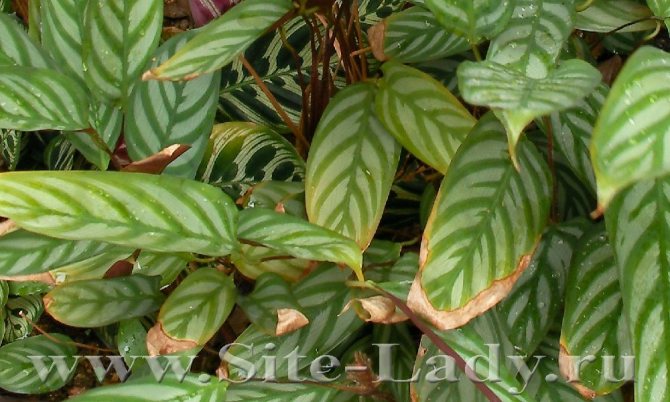

The ability of the Ktenant includes the disclosure of will and effectiveness. Households notice the solution to many problems, the achievement of difficult goals, and successful deals.
Helping people in the personal sphere, the flower stimulates them to take decisive actions in the work area to achieve the set prospects. Happiness and well-being in the family helps to increase self-esteem and assess their abilities, which, with apathy, stress, decrease and interfere with common sense.
The presence of a flower in the nursery will allow the child to reveal their abilities and craving for humanitarian subjects.
The child begins to learn better, perceives new topics more easily and concentrates on studies and other activities.
If the child is still very young, then it is better to rearrange the pot with the plant to other available rooms. This is due to the presence of poisonous sap in the organs of the flower, which are dangerous for babies and pets.
This "green pet" will only help if you believe his magical abilities. A plant cannot accumulate its energy and strength if the whole room is filled with negativity, mistrust and disappointment.
People's faith will help create a positive aura and protect the home and its household. The lined shield will hold back the dangerous gaze of strangers, black power and bad luck.
Nothing decorates a home interior like exotic indoor plants with an unusual appearance. A compact, but very bright ktenanta is the best suited for this purpose, however, in order for this flower to look healthy and lush, it needs to create quite certain conditions. Which ones are described in this review.
Origin of ktenants and appearance
The homeland of all plants of the bright family of Marantovy is South America. Ktenanta (or ktenante) is no exception. She comes from the humid and warm Latin American jungle. There the ktenanta feels great in the laced spots of the sun under the shade of tall trees. In its natural environment, this herbaceous perennial plant lives in Costa Rica, Ecuador, Peru, Colombia and Brazil.
Ktenanta is translated from Greek as a comb flower. It is believed that the name was given to it due to the fact that the unevenly spaced leaves from a distance resemble a comb.
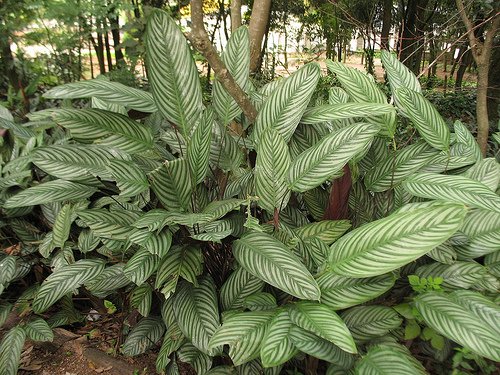

Homeland ktenants - South American rainforests with a humid and warm climate
Ktenanta is often confused with its closest relatives: arrowroot, stromant, and especially with calathea. Some varieties are difficult to recognize even by a specialist. Plants have a similar appearance and similar preferences. All of them are afraid of the burning sun and cold, and rejoice in high humidity. However, ctenants differ from other arrowroots in the greater length of the petioles and the oval-elongated shape of the leaf plate.


The difference between ktenants and other arrowroots is longer petioles
The flowering of the ktenanty does not make an impression, its paniculate pale pink or white inflorescences are small and dim. But she does not need lush flowers. Florists appreciate the richly decorated foliage of this plant. It is velvety and painted with whimsical ornaments, symmetrical or chaotic. The top of the leaf can be of different shades of green, silvery with stripes, spots, streaks of white or pink. The bottom is most often purple-burgundy.
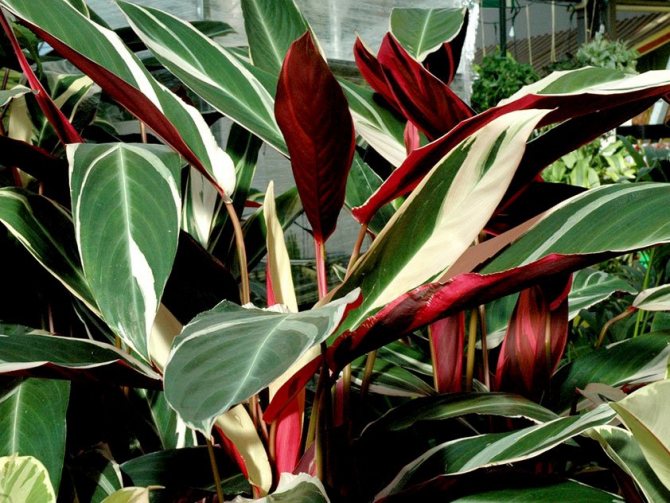

Ktenanta is appreciated for its brightly colored luxurious foliage.
The beauty of ktenants will require from the florist, of course, not sacrifices, but the creation of special conditions and increased attention to his person. ThoseThose who claim that arrowroots are easy to use at home are a little cunning.Or they have been growing these plants for a long time and have studied all the habits thoroughly. For example, spraying should become a daily procedure, watering should be dosed, the hot sun burns, and the lack of light kills the beauty of the leaves. But despite all the difficulties, ktenants are popular, for the sake of them flower growers are ready to spend time and effort.
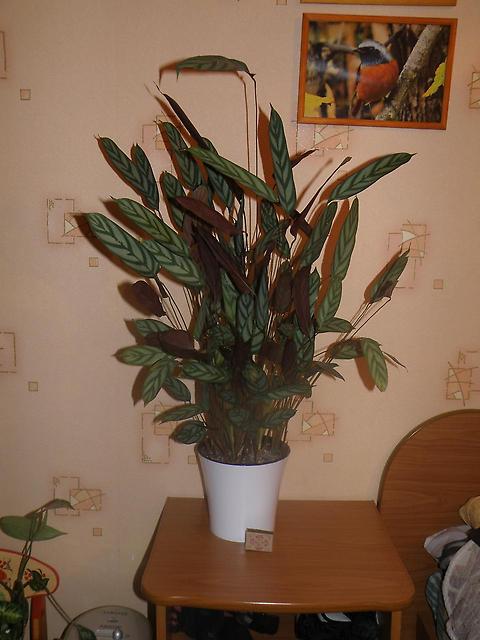

Ktenanta is not the easiest flower to care for, but he has many loyal fans who successfully grow it.
The charm of prayer
Arrowroot plants are popularly called praying for the fact that in the evening, at sunset, they raise and touchingly fold the leaves. So they try to get more light, sometimes prayer anticipates changes in the weather, indicating an imminent rain.
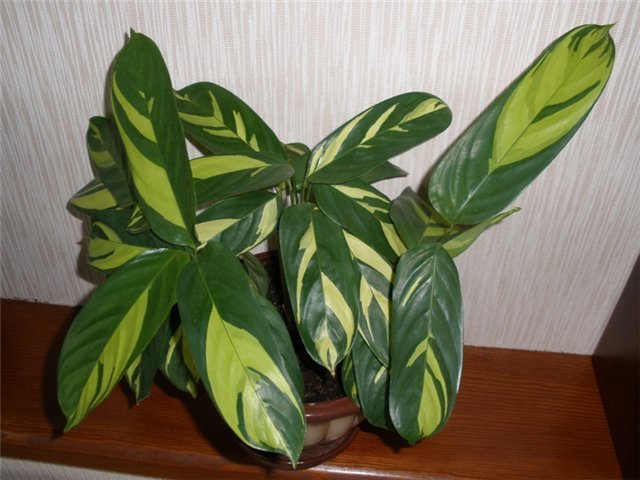

Leaves of ktenants react to changing conditions, in a healthy plant they rise in the evening
In the ktenanta, this generic feature is very well expressed. And since the leaf plates are rather large and the petioles are long, the plant emits a characteristic rustling. Most growers are delighted with this "charging". Their flower smiles and waves. Tenant owners know that leaf movement can also indicate problems. If the plant has lowered them and almost pressed them against the petioles, it is most likely hot and dry. Then it is worth checking the soil, moistening the leaves.
Video: ktenanta raises leaves
Microclimate
As a true inhabitant of the tropics, the comb flower makes very high demands on temperature, lighting and humidity. If these conditions are not met, the plant can be easily lost, so you need to worry about them in advance.
Location
When choosing a place for a crocodile leaf, you need to take into account the peculiarities of the growth of this flower in nature. There the ktenanta prefers to hide in the shade of tall trees, while constantly being in a very humid and warm environment, typical of the tropics. Thus, in room conditions, the flower will be equally uncomfortable with both the southern and northern windows: in the first case, too bright sun and dry air play a negative role, in the second, on the contrary, a lack of light and heat. From this point of view, it is optimal to place the pot near the east or west windows. In the absence of such an opportunity, on the south side, the flower will need to be removed away from the window, on the north side - additional lighting will be required.
Lighting
In summer, direct sunlight is the most dangerous for the crocodile leaf. In general, the plant is shade-loving, so it feels quite comfortable in partial shade. However, in winter, when the number of clear days in the middle lane is sharply reduced, the flower begins to experience a lack of light and warmth. Based on these rules, lighting must be correctly varied depending on the season. The state of the ornamental leaves will tell you how correctly this condition is fulfilled: their size decreases, and the brightness of the color is lost in cases of excess light, with insufficient illumination, the leaf plate becomes sluggish.
Temperature
The comb flower is not as demanding to the temperature regime as to other climatic conditions, however, it is very important for the plant that these parameters are constant: the flower does not like sudden temperature changes, including day and night.
The leaf feels best for crocodiles when the soil temperature is in the range of + 18… + 22 ºC, air temperature - + 22… + 25 ºC. It is advisable not to allow the room to cool below +18 ° С, a critical indicator at which the plant can no longer develop normally is cooling to +16 ° С.
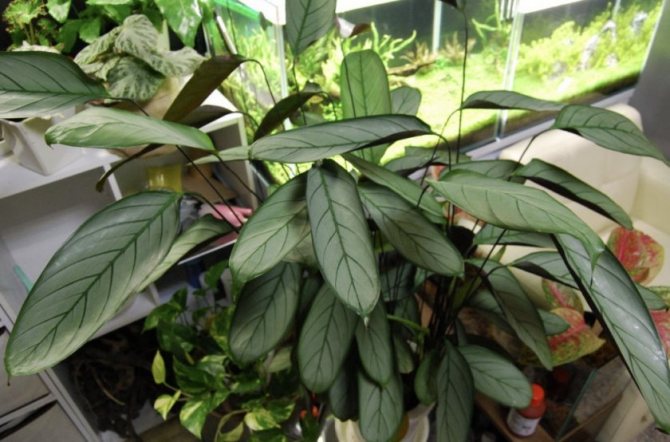

Air humidity
At home, the most difficult thing is to provide the ktenant with sufficient air humidity. The plant needs an indicator at a level of at least 70%, better - up to 90%, which is almost impossible to achieve in residential premises.
Some growers place the ktenant in decorative florariums, aquariums or terrariums, where it is much easier to create a suitable microclimate for the plant.


Growing difficulties
Violation of the requirements for plant care can lead to various diseases. Usually, by the appearance of ornamental leaves and other characteristic features, you can easily determine what exactly is lacking in a comb flower.
Diseases
When growing a plant, you can face the following problems:
- Shriveled and drooping leaves. A clear signal that the indoor air is too dry. The problem is eliminated by humidification.
- Darkening of the tips of the leaves also speaks of low air humidity.
- Lethargy and rotting of the leaf plate. Usually occurs when the air temperature is unacceptably low. Place the pot in a warmer place.
- Light spots on the sheet. This is how the plant reacts to direct sunlight, especially if it was sprayed with water. The flower must be shaded.
- Dark spots on the leaf plate. The reason is stagnation of water in the soil. This is especially true for the period when the room temperature drops. It is necessary to adjust the watering and, if necessary, transplant the flower, providing reliable drainage in the new pot.
- Asymmetric growth, characteristic bias towards the window. Occurs when there is not enough sunlight for the flower. You should move the flowerpot to a more suitable place or arrange artificial lighting for the plant.
- The appearance of a "black leg" on the stem, brown spots on the green parts, the presence of mold on the surface of the earthen coma, sometimes the presence of an unpleasant smell of rotting emanating from the soil. Indicates the development of root rot - a dangerous fungal infection. If you start a disease, the plant will die, and it will need to be thrown away along with the soil in which it grew. Radical treatment is required: the bush is cut so that only perfectly healthy shoots remain on it. The sections are disinfected (wood ash, activated carbon or crushed chalk can be used). The plant is removed from the pot, the roots are freed from the ground and washed in a solution of fungicide such as Topaz, Abiga-Peak, Previkur, Alirin-B, Baikal-EM or Skor, after which in the same the solution is soaked for 30 minutes. Then the flower is transplanted into a new pot with completely fresh soil (the old substrate cannot be reused). Over the next several months, a fungicide should be added to the irrigation water for prophylaxis.


Pests
Of the pests for ktenants, the danger is:
- aphid;
- shield;
- mealybug;
- spider mite;
- whitefly.
Each of these parasites leaves traces characteristic only of it, and some (for example, aphids or scale insects) can even be seen with the naked eye. However, in general, it is quite easy to distinguish a pest attack from problems associated with an improper microclimate: extraneous formations appear on the leaves or stems of the plant (sticky streaks, bulging plaques, similar to spider webs).
Regardless of what kind of parasite caused this phenomenon, an effective method of treatment is to treat the green parts of the flower with water with the addition of soap, alcohol, crushed garlic or onion juice. In case of severe damage, the flower must be sprayed with a special preparation, in order to avoid mistakes, it is better to use universal agents - both against insects and against ticks. Among the most well-known drugs suitable for these purposes, one can name, for example, "Akarin", "Actellik", "Aktofit", "Apollo", "Vermitic", "Fitoverm" or "Fufanon".
Transplant procedure and preparation for it
For ktenants under the age of five, the transplant is an annual procedure. Adult specimens are moved to a new pot less often - every 2-3 years. At the same time, the top 2-3 cm of the soil are changed annually. The best time for the procedure is late spring or early summer.
The container is taken wide and shallow, similar to a bowl. Each time, its diameter is increased by 5–7 cm. The best material is unglazed ceramics, in which the soil sour much less often.
The soil needs enough nutritious, but at the same time it is well permeable to air and water, slightly acidic. A special mixture for arrowroot is rarely found on sale, so it is prepared independently from leafy soil, peat chips, coarse river sand (2: 1: 1) and pieces of charcoal, finely chopped sphagnum moss (about 5% of the total volume of the mixture). An alternative is a commercially available azalea substrate.


Soil for Marantovs is rare on sale, but it can be replaced with a self-prepared mixture, all components of which are readily available
The transplant itself looks like this:
- Pour expanded clay or pebbles into a new pot (layer 2-3 cm thick). Above - about the same amount of fresh soil.
- Remove the ktenant from the old container. It is easier to do this if you water the plant abundantly in about half an hour. Try to keep the earth ball intact.
- Trim off dried leaves. Do the same with dead and / or decayed roots. Sprinkle the "wounds" with crushed chalk, activated carbon, cinnamon.
- Place the earthen ball in a new pot, add the substrate around the edges. When finished, gently shake the container to fill any voids.
- Do not water the plant for 3-5 days. Protect it especially carefully from direct sunlight. This will help minimize the stress you have suffered.


The ktenant is transplanted by dividing the bush, trying not to destroy the earthen lump
Video: transplanting plants from the Marantov family
Description
Stromanta - home care and reproduction
Most species of ktenanti have an interesting contrasting leaf. The homeland of this plant is South America, where this evergreen deciduous shrub can be easily found in its usual habitat - in the jungle.
In wildlife, a ktenant can grow very strongly
For such a flower as a ktenant, care at home is not too difficult to organize. This native of the tropics is not overly whimsical. Due to its very compact size, the ktenant's flower will perfectly fit into even the smallest room.
Blooming ktenants when caring for her at home is a rather rare phenomenon. Even if the plant is provided with as close to natural conditions as possible, it is not at all a fact that buds will ever appear. However, most flower growers are not at all upset by this fact - the flower looks as a whole rather nondescript. It is a small spikelet of red or white color.
Important! The fact that a ktenanta of any kind practically does not bloom in an apartment environment makes it the best option for people who are allergic to pollen.
Features ktenant
All ktenants have the unique ability to turn leaves. We already know that arrowroots lift the leaves up at night, as in prayer, and spread them in the morning - this is how they orient themselves in space relative to the light, for this in their homeland - in the countries of Latin America, all arrowroots are called praying plants. But the pursuit of the sun (light source) is not the only reason for leaf turning. Sometimes movement is a pronounced defensive reaction; in sunny weather, the plant turns the leaves in order to reduce transpiration, excessive evaporation of moisture. If you look closely, the leaves turn along the light flux, sideways to the sun, by the edge of the leaf - this way the heating surface is less than when the leaves are in a horizontal position. Moreover, interestingly, the plant chooses what is more convenient for it - it can lift the leaves up, or lower them, almost perpendicular to the floor. Pay attention, if your ktenant suddenly pressed the leaves to the petioles on a spring or summer day, she may be hot or dry! The sun may no longer shine through the window, but the leaves are still pressed against the petioles.The fact is that in this position, moisture evaporation also occurs in a more economical mode - the moisture inside the bush, between the petioles and pressed leaves is preserved better than when the leaves are spread.
By the way, all other arrowroots can behave in exactly the same way, but only in ktenants, stromanths and some kalateas (large long-petiolate), this process is more pronounced. In arrowroot, the stem growth is different - semi-creeping, forming many nodes, and the bush is compact, so the arrowroots from the heat also shrink like bristling hedgehogs, or the leaves are pulled closer to the walls of the pot.
Thus, observing your ktenant (or other arrowroot), you can understand - it is hot for her, too intense the sun, or both. To avoid burns and not overheat - the leaves will become an edge towards the light. But if there is no sun, look at the thermometer - it may be too stuffy, hot, remember how long you watered. With very strong drying, the leaves become lethargic, like rags, but before that the plant will do everything to save moisture evaporation - it will squeeze the leaves.
In some cases, the leaves on one side of the plant are lowered, and on the other, they are raised, so you can observe the reaction to the currents of warm air from the battery and the orientation of the plant to the light source.
Conditions for a moisture-loving tropicana
When choosing where to put a pot with a ktenant, remember her innate habits: love of warmth, humidity and diffused light. Direct sun, hot, air-drying battery, gusts of cold air - this is not for a tropical plant. And the windowsill is not the best place for ktenants: in spring and summer - too bright light, harmful to the leaves, in autumn and winter - cold, harmful to the roots.
Seasonal conditions (table)
| Season | Lighting | Humidity | Temperature |
| Spring | Ktenants prefer diffused light, they feel good in light partial shade. The best growing areas are the east and west sides. Or south, but not by the window, but in the back of the room. Shade from the midday sun. Direct sun will discolor the elegant foliage and make it smaller. | Very high, 80–90%. Take care of hydration.
| Moderate, + 20–220 C. Protect from drafts. Ktenanta does not tolerate sudden temperature fluctuations. |
| Summer | Moderate and slightly higher, + 20-26 0С. Protect from heat and temperature extremes. | ||
| Fall | |||
| Winter | Well lit areas, but away from direct sun. Add artificial lighting. Daylight hours for ktenants should last 14-16 hours. | High, 80–90%. Do not place the plant next to heating appliances. Spray the leaves and stems at least 3 times a week. Humidify the air in any way you can. | Moderate, 18–200 C, slightly cool. It should not fall below +15. |
About florarium for indoor flower
The younger the ktenant, the higher the humidity should be, the florists noticed. Miniature varieties are also more moisture-loving than tall ones. A beauty from tropical swamps often lacks moisture in apartments where the air is dried by heating devices. She loves the greenhouse environment that can be created in an open florarium or aquarium garden.


Ktenanta feels great in a wet florarium
However, tall ktenants can be grown there until a certain age, as long as the size allows. And compact, slow-growing varieties will become permanent residents of the jungle in the aquarium. Match plants with the same conditions and plant them together. There is almost no need to look after them. The inhabitants of the florarium themselves create a microclimate that they like.
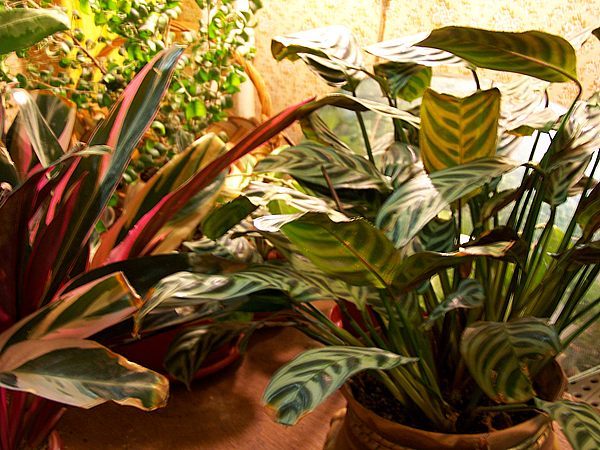

Compact varieties of ktenants grow very well in an open or closed florarium
How to make an open florarium
- Take a clear container or aquarium.
- Fill the bottom with drainage material, top - with a porous soil substrate.
- Plant moisture-loving miniature plants.
- Moisten the plantings, cover the florarium with a lid or just glass.
- Place it in a warm and bright place, without direct sun.
- Ventilate the mini jungle if condensation occurs.
- Water your plants and clean your aquarium every few months.
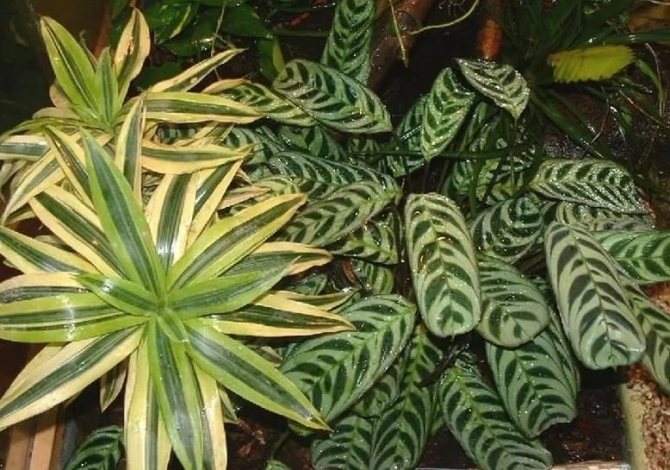

Plants with similar requirements should be neighbors in the florarium.
Neighbors ktenants on the florarium
If you decide to plant an aquarium or bottle garden, choose plants with the same preference. Together with the ktenant, you can plant other arrowroots, royal begonia (small-leaved), calamus, ferns, peperomia, beautiful neanthus, pilea, fittonia, crotons, rheo.
The smallest ktenants, for example the Amagris variety, can be grown in a bottle garden, as the indoor florarium is sometimes called. In contrast to the open (aquarium) container, they are taken with a rather narrow neck, which is tightly closed with a lid. After planting, the bottle garden is watered only once, and then sealed and not opened. Plants live in a closed ecosystem, independently providing themselves with air and moisture. A garden in a bottle looks very original, it does not need to be looked after. However, taste and dexterity will be needed to place the green inhabitants in a picturesque and neat way.
Video: master class on planting a florarium
Transplant features
Young specimens are usually replanted annually in late spring. Older plants are quite capable of growing in one place for about 3-5 years.
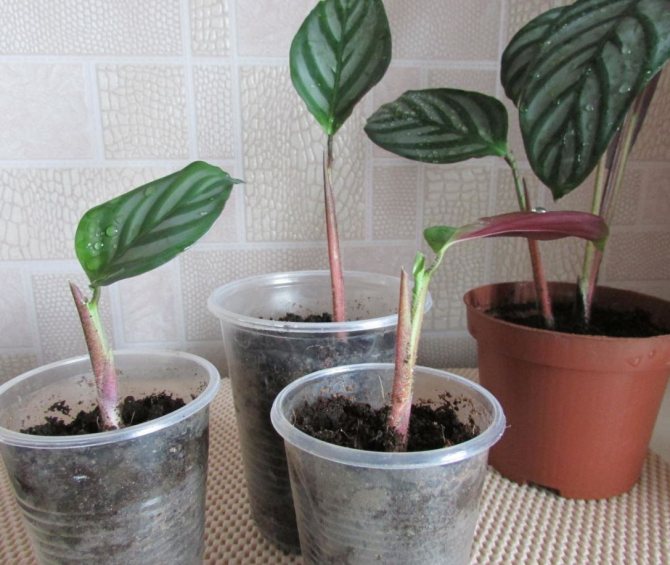

It is necessary to transplant the ktenant very carefully
When transplanting, especially close attention should be paid to the size of the pot. It is selected in direct proportion to the size of the rhizome. In no case should you choose too large a container. The plant will be uncomfortable in it. Excess soil can turn sour and become a place for mushroom mosquitoes to accumulate. The best option would be ceramic pots, in which moisture evaporates, including through the side walls.
Popular varieties
There are a large number of tropical flower varieties, therefore, it is worth considering in more detail those varieties that are best suited for planting in an apartment on a windowsill.
Ktenant Oppenheim
Dieffenbachia - home care, reproduction
Ktenant Oppenheim creates a minimum of problems in home care. It is often chosen by those who do not like to spend a lot of time caring for flowers. Ktenanta Oppenheim is a fairly tall species that grows in a pot up to 120 cm, in nature - up to almost 2 meters. The leaves of this variety are characterized by a lanceolate shape. They grow up to 20 or 30 cm in length. The color of the foliage of Oppenheim's calathea is an alternation of grayish-green and gray stripes.
Ktenanta Lubbers
Ktenanta Lubbers is another optimal variety for the windowsill. It is very easy to look after him. The description of the variety is as follows: plant height - from 80 to 100 cm, oblong leaves, dark green above, pale green with variegated veins in the lower part.
Ktenanta Amagris
Many people know Ktenant Amagris. This herbaceous perennial has oval oblong leaves that range in length from 15 to 25 centimeters. Their color is silvery green, very light, along the veins there are thin stripes of a dark green hue. Another feature of the Amagris leaf is the burgundy shade of its lower part. All together it looks very impressive and original.
Ktenanta pubescent
Among the flowers, ktenants of different species of ktenant, pubescent is considered the most capricious.The plant is especially picky about air humidity, temperature and drafts. The flower looks very interesting. It has dark green ovoid leaves with light green stripes. The latter look as if they were painted with paint with a brush. The variety grows pubescent up to 80 centimeters in height.
Ktenanta compressed
Another interesting variety, which often has a place on the windowsills, is the compressed calathea. This species grows to an average of 90 cm. Among the features of the compressed ctenants are glossy oval-shaped leaves, the length of which can reach 30 cm. They are usually located on high basal carts. At the same time, the leaf blades are whole-edged, dark green saturated shade.
Ktenanta Burle Maxi
Many people know Ktenanta Burle Maxi as the smallest plant in the family (up to 20 cm), which is characterized by very original colored leaves. The foliage itself is thick, almost rectangular in shape with wide dark stripes and a dark purple seamy side. In nature, Burle Maxi forms an almost continuous carpet, consisting of bright leaves, the length of which is 10 cm, the width is 5 cm.
Ktenanta Setosa
Ctenant Setoses have elongated dark green ovoid leaves. The longitudinal stripes located on them are most often painted in a gray or light green shade. Plant height can reach 80-90 centimeters. The perennial feels quite comfortable as a houseplant and does not require special conditions for successful cultivation.
Ktenanta Tricolor
The main feature of the tricolorr ctenants is (as the name suggests) tricolor leaves. It is a hybrid of the Oppenheim variety, with striped yellow-green leaves and a bright purple underside. Outwardly, the flower resembles one of the varieties of Stromant.
Important! Ktenanta is a poisonous flower. It is not recommended to grow it in homes where pets live.
Feeding rules
Ktenanta does not like an excess of fertilizers, this must be taken into account and restrain your desire to often water it with nutrients. Her well-being is badly affected by the increased level of calcium and nitrogen in the soil. In the cold season, it will be enough to feed the pet once a month. In the spring and summer, this procedure should be performed more often - once every two weeks.
What fertilizer to choose for this? It is best to take complex compositions for indoor decorative deciduous plants. The most convenient fertilizer is in liquid form. And one moment. The instructions always indicate a high dosage. It is recommended to use it in half the dose.
But there is another option. If you have prepared high-quality soil, then the plant will not lack nutrients. An annual transplant serves the same purpose. If you adhere to the principles of regular soil renewal in pots, then you do not need to think about feeding. They will just be superfluous.
Photo ktenants
Flower ktenants bundle-shaped
Plant height - 0.6-1 m. Attract attention with a unique geometric pattern. The color of the leaf varies from almost white to almost marsh.
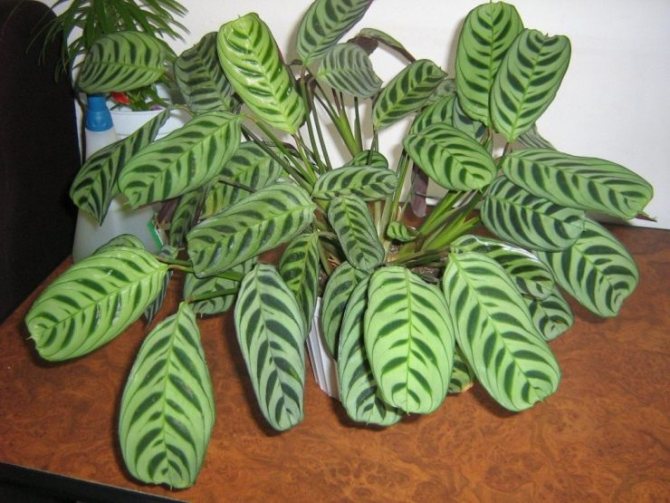

Quite often the leaves of the ktenants are so thin that its plates shine through in the sun, which gives the plant a kind of “fabulousness”.
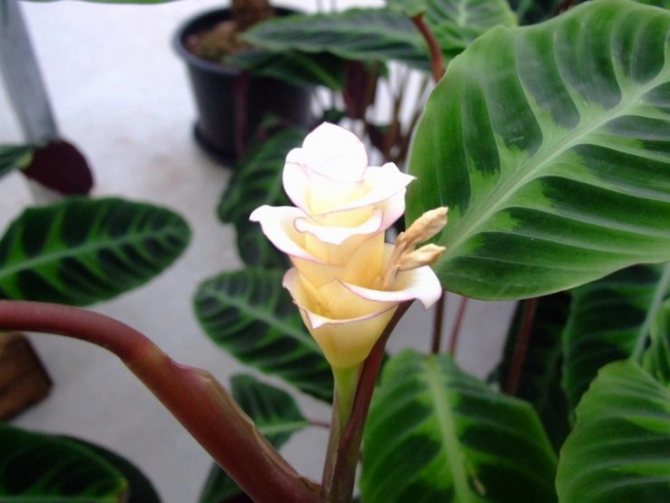

From the history of appearance
The flower is native to South America. More specifically, from the tropical rainforests of Costa Rica and Brazil. The plant belongs to the Marantov family. As a room, it began to be grown in the last century. Initially, no more than a dozen varieties were suitable for home cultivation, but on their basis, a fairly large number of hybrids were created by specialist breeders. Today there is a very diverse mosaic of species of ktenanti. Moreover, the brightest representatives are hybrids of the original varieties.
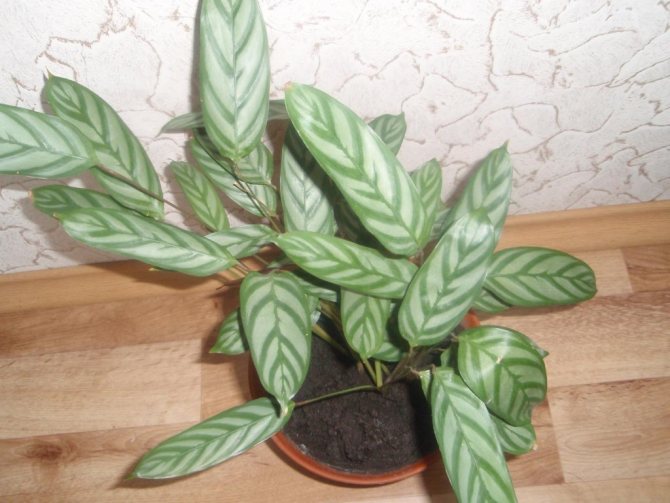

Ktenanta is able to decorate any interior
Types of Ktenant:
- Ktenant Oppenheim (Ctenanthe oppenheimiana).
- Ktenanta compressed (Ctenanthe compressa).
- Ktenant Burl-Marx (Ctenanthe burle-marxii).
- Ktenant Lubbers (Ctenanthe lubbersiana).
- Ktenanta pubescent (Ctenanthe setosa).
You can read about creating a florarium and a garden in a bottle with your own hands using Ktenanta in a separate article: We create a garden in a bottle and a florarium with our own hands.
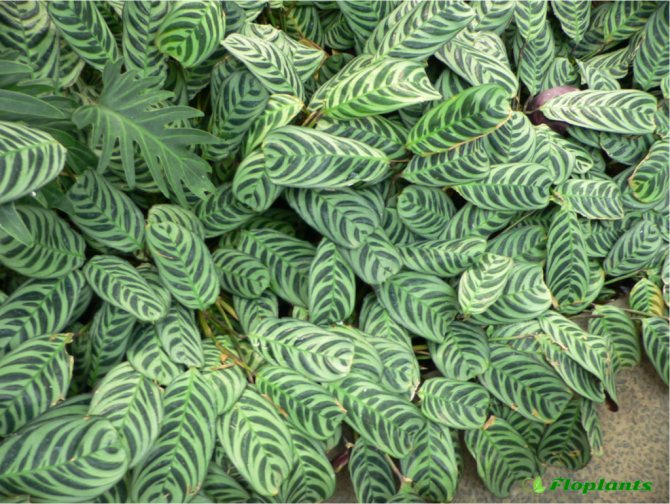

Ctenanthe burle marxii.

